

SCHOOL OF ROCK
THE DIRTY TURKEYS
Iconic waterfront living redefined



BEACH COUNTY, FLORIDA



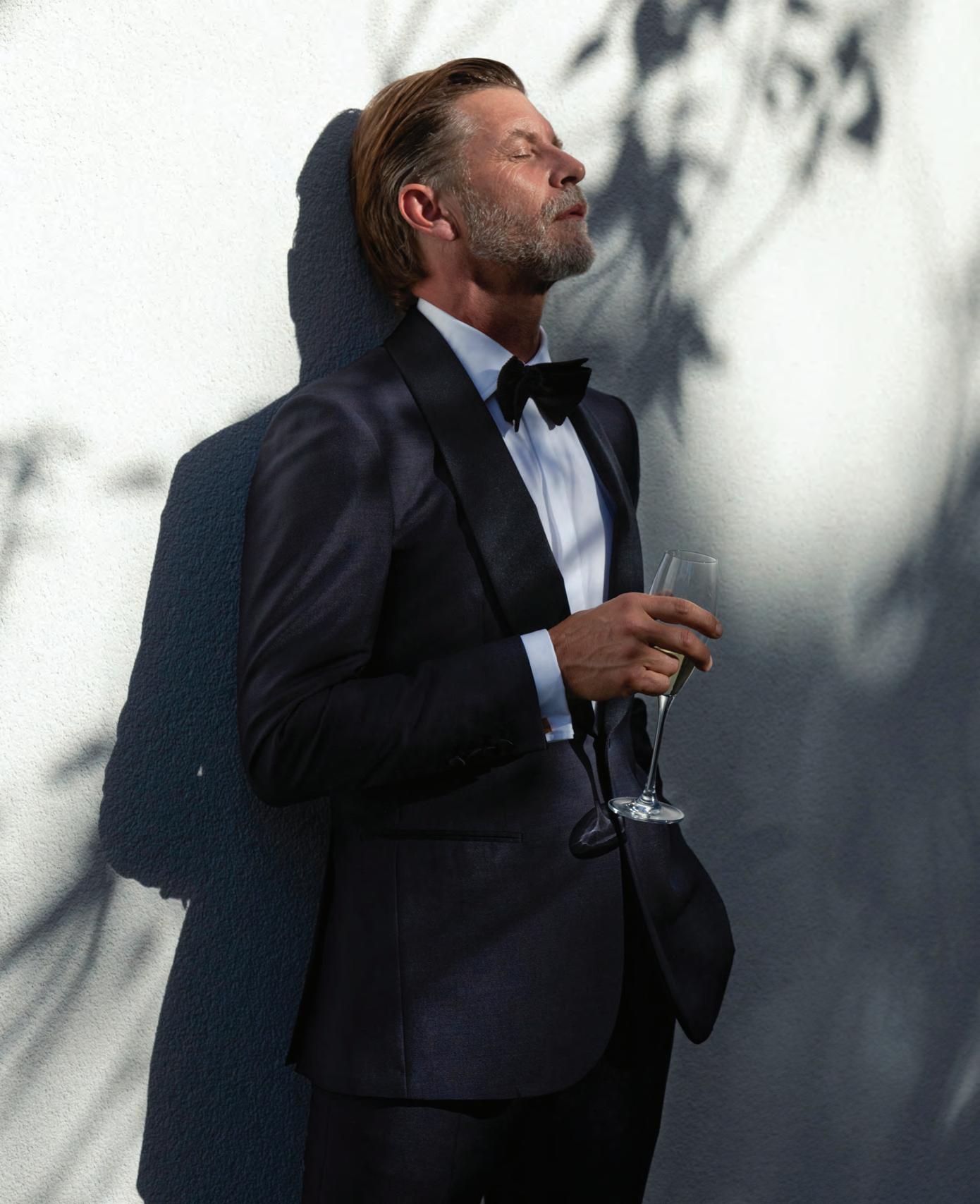

52
FEATURES
100 ROOMS
Author Carl Dellatore’s fifth book, 100 Rooms , is an A-Z in high design— with contributions from Steven Gambrel, Mark Sikes, Bunny Williams and Miles Redd. By Peter Davis
60 TREASURE TROVE
Féau Boiseries, Paris’ historic house of boiseries opens in New York. By Ted Hildner

68 PORTUGAL’S SOCIAL EMPIRE: THE JNÇQUOI UNIVERSE
Lisbon has never been more fun or more stylish. Meet Miguel Guedes de Sousa and his wife Paula Amorim, the brains behind Portugal’s style revolution. By Janet Mercel
74 SCHOOL OF ROCK
The Dirty Turkeys got together while students at the University of Colorado. With (recent) diplomas in hand, they’re primed for global rock n’ roll stardom. By Peter Davis

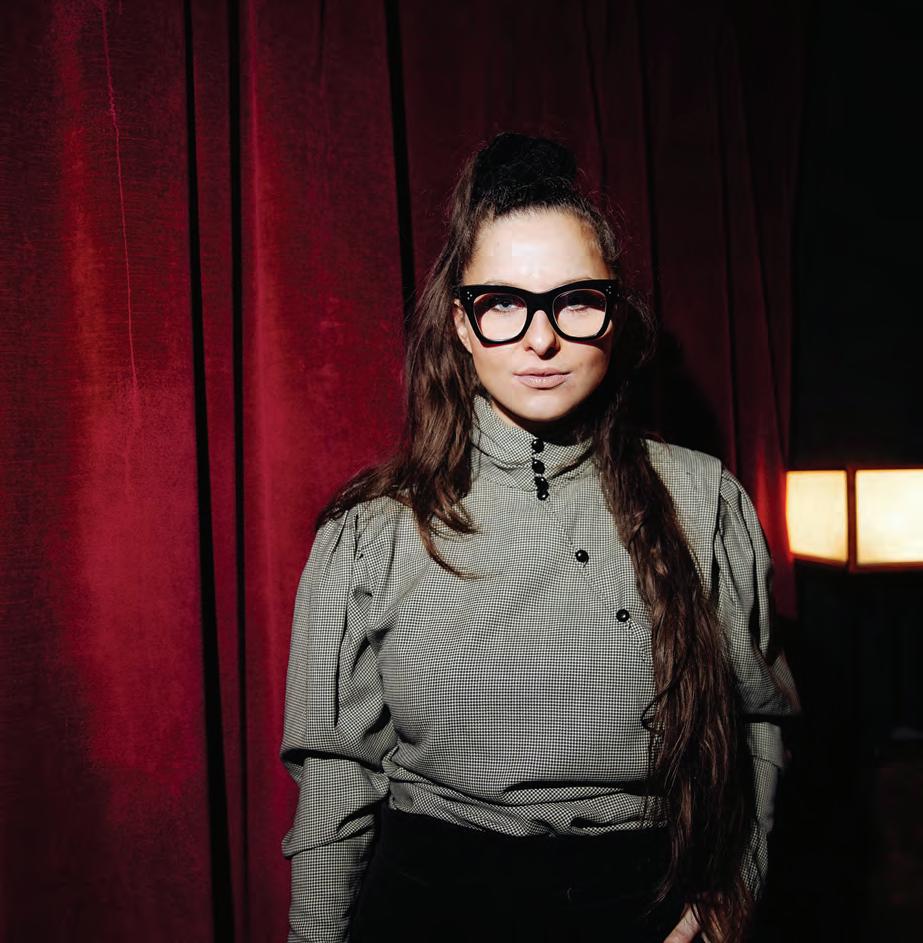
CULTURE
20 GALLERY GIRL
Molly Krause, the art world’s secret weapon. BY JANET
MERCEL
24
ENTIRE THE HOUSE OF MCQUEEN
DUGAZON , Connecticut’s new design Mecca, J. LOGAN HORNE’s eponymous fashion and home line. 14 BOWERY
BOY
NUR KHAN opens Maison Nur downtown. BY PETER DAVIS
20
Bridgerton heartthrob Luke Newton plays the late, great fashion designer Alexander McQueen at the Mansion in Hudson Yards. BY
JANET MERCEL
TATIANA VON FURSTENBERG
Tatiana von Furstenberg becomes 14-year-old Augusta in My Sunburned
31
Summer who discovers her father is gay while on summer vacation. BY PETER DAVIS AROUND TOWN
D&D DIRECTORY
A guide to New York’s eminent design hub.
JOURNEYS
82
FORTE DEI MARMI: THE HAMPTONS OF ITALY
Forget another weekend in Sag Harbor—book a trip to Italy’s answer to the Hamptons: The Agnellifamily approved Forte dei Marmi. BY JANET MERCEL
NOTORIOUS NEW YORKERS
90 TEDDY ROOSEVELT: THE FIFTH AVENUE GLADIATOR BY JANET MERCEL
92 Q&AVE
James Franco has a new DIY label called Paly, using images and words to turn Hollywood’s hidden, often-dark history into fashion. BY MAGGIE DAVIS
EYE ON ART AND DESIGN
Molly Krause (right), Forte dei Marmi (below).
COVER: Illustration by Cecilia Carlstedt




Editor’s Letter
AVENUE is like the best dinner party you’ve ever been to—where you meet the most interesting, talented, and often unexpected people. In this issue, we introduce you to Molly Krause, the art world It Girl behind some of the best gallery openings and cultural extravaganzas in the city. We talk to Bridgerton heartthrob Luke Newton, who tears up the stage playing the tormented, late great fashion designer Alexander McQueen in the play about his life House of McQueen. And we jet to Portugal to hold court with Europe’s new social king and queen: Miguel de Sousa and wife Paula Amorim, the couple behind Lisbon’s cheeky and chic member’s club JNcQUOI that’s become a favorite destination of Nate Berkus, Tory Burch, and Neil Patrick Harris.
It’s our Design Issue and we score a first look at Féau & Cie’s first New York show palace, in the storied D&D Building. Féau’s phenomenal Paris atelier, which opened in 1875, is legendary among the design elite and clients that have included Karl Lagerfeld, Boni de Castellane, and Henry Clay Frick, who used Féau’s gilded boiseries when building his Fifth Avenue mansion. Guillaume Féau describes the atelier as “a maze of rooms that flow into one another like a treasure hunt.” There are more design trophies in our feature with author Carl Dellatore, whose new book 100 Rooms is a master class in high design with contributions by Miles Redd, Bunny Williams, Steven Gambrel, and Mark Sikes, to name a few.
Our Design Issue might inspire you to redecorate a room–perhaps your dining room—so you can throw the best dinner party in town. Cheers!
Cheers!
PETER DAVIS Editor-in-Chief
EDITOR-IN-CHIEF
Peter Davis
CREATIVE DIRECTOR
Natalie D. Kaczinski
ART DIRECTOR
Mickey McCranor
EXECUTIVE EDITOR
Janet Mercel
DEPUTY EDITOR
Ted Hildner
EDITOR-AT-LARGE
Alexander Hankin
PHOTOGRAPHER-AT-LARGE
Landon Nordeman
COPY EDITOR
Christina Snyder
Faith Cummings
EDITORIAL ASSISTANT
Maggie Davis
CONTRIBUTING WRITERS
Mike Albo
Mickey Boardman
Ty Gaskins
Carson Griffith
Nancy Kane
Ray Rogers
Zachary Weiss
Constance C.R. White
CONTRIBUTING PHOTOGRAPHERS
Ben Cope
Sophie Elgort
Edd Horder
Richard Kern
Jai Lennard
Nick Mele
Alexander Thompson
PUBLISHER
Julie Dannenberg
COHEN MEDIA PUBLICATIONS LLC
CHAIRMAN
Charles S. Cohen
GUILDED AGE A dining room by Féau Boiseries.

Beyond Concierge. This is major domo.
From everyday needs to extraordinary moments, Major Domo at Villa Miami doesn’t follow—it leads. Delivering a lifestyle defined by precision, where even the smallest details are managed with quiet intention—seamlessly, behind the scenes.
Half- and Full-Floor Bayfront Residences Starting at $6M.
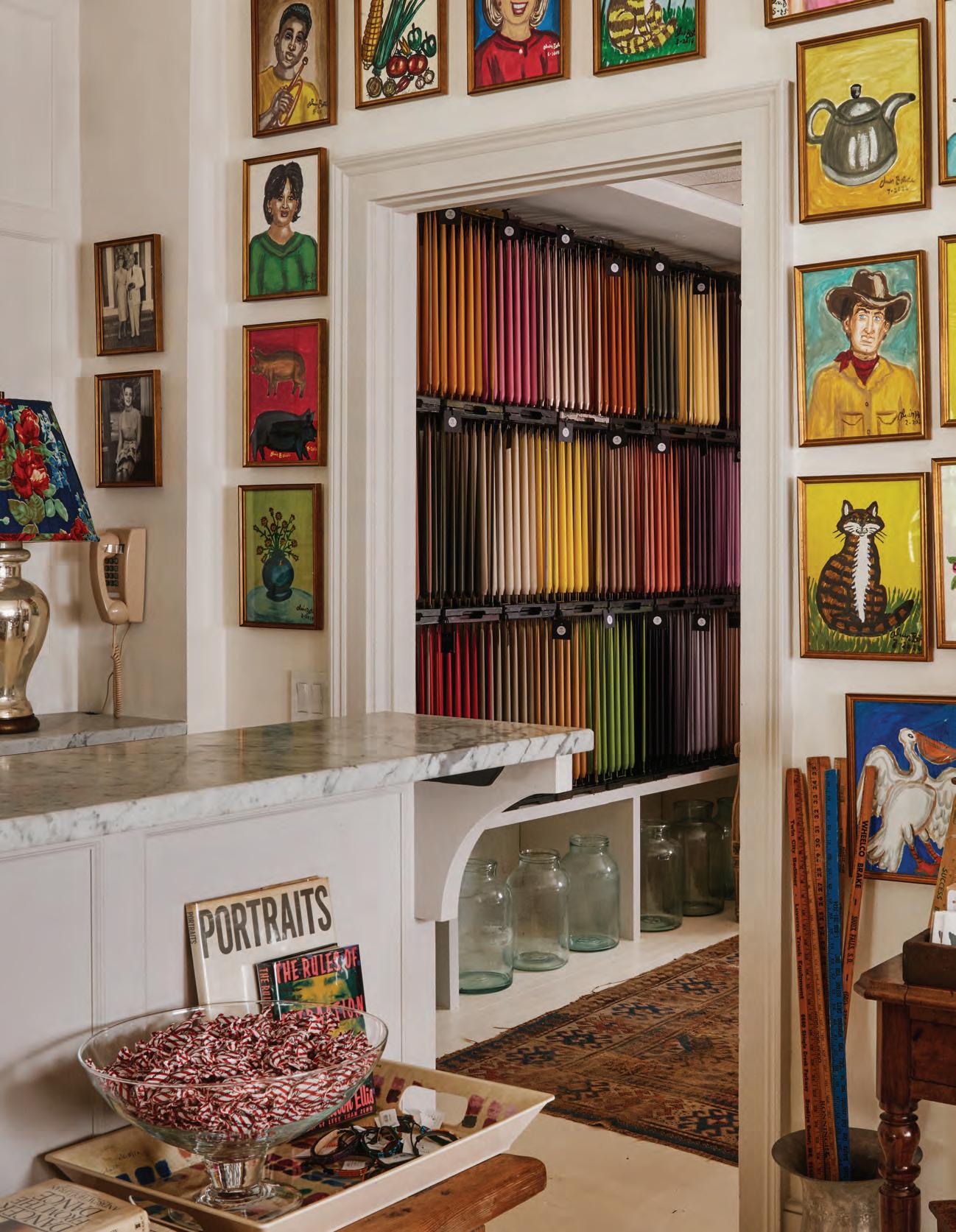
ON THE AVE


Connecticut’s New Design Mecca
Former media powerhouses Bobby Graham and Matthew Marden debut the lifestyle store Dugazon.
Sharon, Connecticut has always been a secret society enclave. Carolyn Roehm has her house Weatherstone, and Kevin Bacon and Kyra Sedgwick have a 40acre farm. Jasper Johns lives and works in Sharon too, and at 95, has decided to turn his pastoral estate into an artist’s retreat when he dies. Forget the Hamptons–Connecticut is the height of chic. And now Sharon has Dugazon, Bobby Graham and Matthew Marden’s design and curio superstore on Main Street.
Once the local watering hole (rumor has it they might still pour you something good), Dugazon is like hanging out at your stylish friend’s country house. “We want to create a collected experience, rather than a decorated one,” Graham says. “It’s simple. We sell what we love.” Vintage Tabasco
holders, paintings by self-taught Louisiana artist Alvin Batiste, Junior League cookbooks and sexy black and white surf photographs by Matt Albiani fill the space. In the back room, a kaleidoscope wall of candles in over 30 shades hang like exotic fruit in the metal cages they were cast in by Ester & Erik of Denmark.
Before Dugazon (the name comes from Graham’s maternal family), Graham spent 24 years at Conde Nast and Marden was a major fashion editor. “Bobby has been talking about Dugazon since our first date 21 years ago,” remembers Marden. “Dugazon comes straight from my creative soul,” Graham says, mentioning they also send out a weekly newsletter featuring family recipes, design ideas and BTS content from the store. “It’s about my entire past, my roots, my family, my friends, and sharing that with the world means everything to us.”
—TED HILDNER
CASA CHIC
Inside Dugazon, Connecticut’s new design destination.


Were you into fashion as a kid?
I was obsessed with California, what celebrities were wearing, and where they were shopping. My dad would take me on business trips to Los Angeles. It was the era of Robertson Boulevard and the Juicy Couture kids. I was heavily influenced by the L.A. lifestyle.
You’re pals with Katy Perry, the ultimate L.A. style star.
I moved to L.A. after high school. She was one of the first people I met, at a party at the Roosevelt Hotel. This was before she was anyone. I partied with Lindsay Lohan, Paris and Nicky Hilton, you know, all the girlies.
J. Logan Horne
A staple in NYC’s cool-kid social scene, J. Logan Horne’s eponymous home and fashion collection has made him a style star with fans like Travis Kelce, Katy Perry, and Dua Lipa.
J. Logan Horne reimagines vintage prints from brands like Hermes, Gucci, and Celine.
I was over fashion. I felt it was wasteful and frivolous. I started thinking about upcycling and sustainability. I was shopping online and saw these amazing scarves. I had a solution to the problem: the goal is to make use of these materials. It’s an homage because I have a lot of admiration for the brands I repurpose. The prints are just as relevant now as they were 30 years ago.
You just launched a capsule collaboration with Fernando Garcia and Laura Kim’s label Monse.
Laura posted pieces from their last collection with a floral football motif. I facilitated the whole
thing while on vacation in France: 10 shirts, 5 pairs of shorts, and awesome home stuff.
Travis Kelce must be your new BFF.
I didn't know who he was, which is embarrassing. I don't follow football, obviously. He bought 10 shirts at once. He wore one to a game and it went viral. That same week, he went public with his relationship with Taylor Swift. He wore one of my shirts to the first concert of hers he attended in Argentina, which also went viral.—ALEXANDER HANKIN

PRINCE OF PRINTS
Horne and his designs which are made from reclaimed vintage pieces.

“I WAS OVER FASHION. I FELT IT WAS WASTEFUL AND FRIVOLOUS. I STARTED THINKING ABOUT UPCYCLING AND SUSTAINABILITY.”

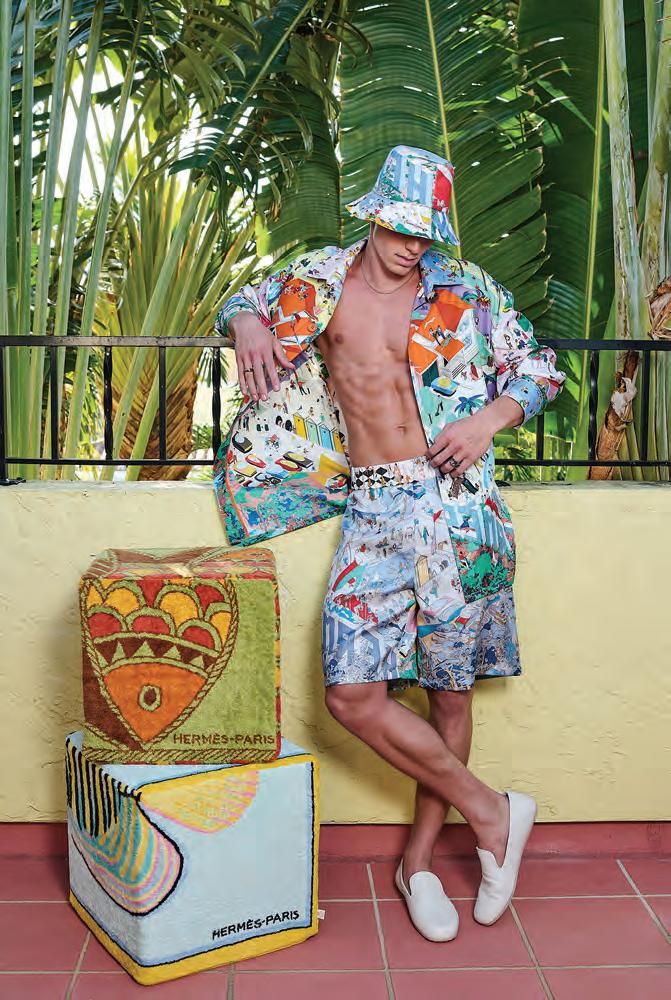
TROPICALE J. Logan
Horne’s collection has an upbeat, island flavor.
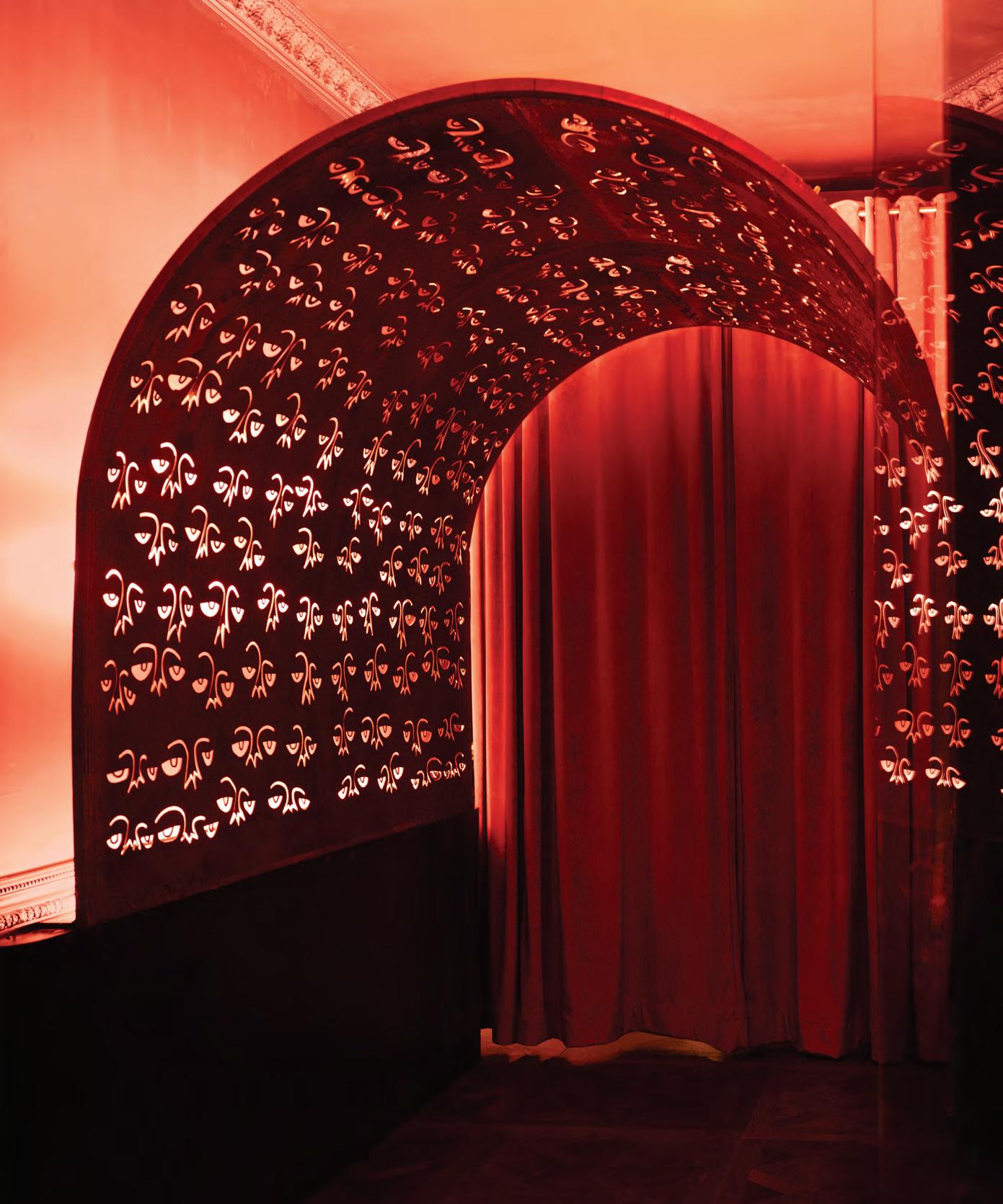


Bowery Boy
Nur Khan, long New York nightlife’s Pied Piper (think Rose Bar, Electric Room, Sway) opens Maison Nur on the Bowery with a Michelin star chef, a scene-y crowd and his own Damien Hirsts on the wall. Peter Davis books a table.
Three leggy blondes in skinny jeans sidle up to the bar and order martinis. Nearby, two guys in navy blue suits and John Lobb shoes ogle the modelesque girls before sending over Petrossian caviar (an expensive flirtation at $158). But before the fish eggs are spread on to bread, one of the girls jumps up and gallops towards the front door as if a fire alarm was pulled. Nur Khan, in his signature leather motorcycle vest and rock ‘n’ roll silver jewelry, has made his entrance. The girls surround Khan like adoring fans by the bar. Electronica music fills the room. A nightlife vet with 3 decades in the city’s late-night trenches, Khan is a pioneer of countless hot spots (Rose Bar, Sway, Electric Room) and a pied piper of cool. The Beautiful People trail Khan wherever he goes, starting in 1995 when he debuted Wax, a moody lounge with a tight door policy. Most recently, Khan opened Two Fifteen with
hotelier and Studio 54 founder Ian Schrager in the Public Hotel. But the most ambitious and personal of all Khan’s project is his newest: Maison Nur, a sophisticated temple to fine dining in the unexpected location of the Bowery.
Entering Maison Nur is like slipping behind the velvet ropes at one of Khan’s clubs. An attractive woman in all-black with an iPad checks reservations and then just beyond heavy gold curtains is a space that feels like a Parisien speakeasy with a slightly punk rock edge. Plush mohair banquettes line a deeply patinated wall, facing a marble bar with four crystal skulls topping the shelves. A large white chandelier made of sawfish nose bones anchors the curved gilded ceiling. There are touches of alligator skin and leopard prints and two circular Damien Hirst butterfly pieces. “All this art came from my apartment,” Khan says, his eyes darting around the restaurant. “My walls at home are empty.” There are also pieces by Araki, Michael Joo, Sante D’Orazio,
CASA KHAN A sculptural piece by artist Harif Guzman at the entrance to Maison Nur.

“It took a while to find a venue that was 100% mine so I could put all my DNA into it. As the sole owner, there was no one else involved to dilute my vision.”
–
Nur Khan
Neil Grayson, and Harif Guzman. Khan created Maison Nur—which feels sexy and secretive, like a private club with a password—with designer Jason Volenec. “I always had these ideas in my head for the design. It took a while to find a venue that was 100% mine so I could put all my DNA into it,” Khan continues. “As the sole owner, there was no one else involved to dilute my vision.” Khan is as serious about cuisine as he is about design. The French-American menu is by Paris native Richard Farnabe, who has won multiple Michelin stars and famously created the most expensive savory souffle at Petrossian. “Maison Nur is the kind of place that guests can visit several times a week and discover dishes they cannot enjoy elsewhere,” Farnabe says. “It starts with superb ingredients—wild-caught fish, grass-fed beef, organic eggs, pure cane sugar.” Khan is thrilled to partner with Farnabe on the food. “We have given Richard full creative freedom to express his vision and cook from his heart.”
Farnabe’s dishes are decadent and delicious: a mushroom mille feuille with artichokes and foie gras, stuffed morels with vin jaune, roasted duck breast with crispy layers of potato and rhubarb, and a Colorado rack of lamb with maitake mushrooms and bone marrow bordelaise. For the less

GOLDEN HOUR
The dining room at Maison Nur features 2 large pieces by Damien Hirst from Khan’s personal collection.
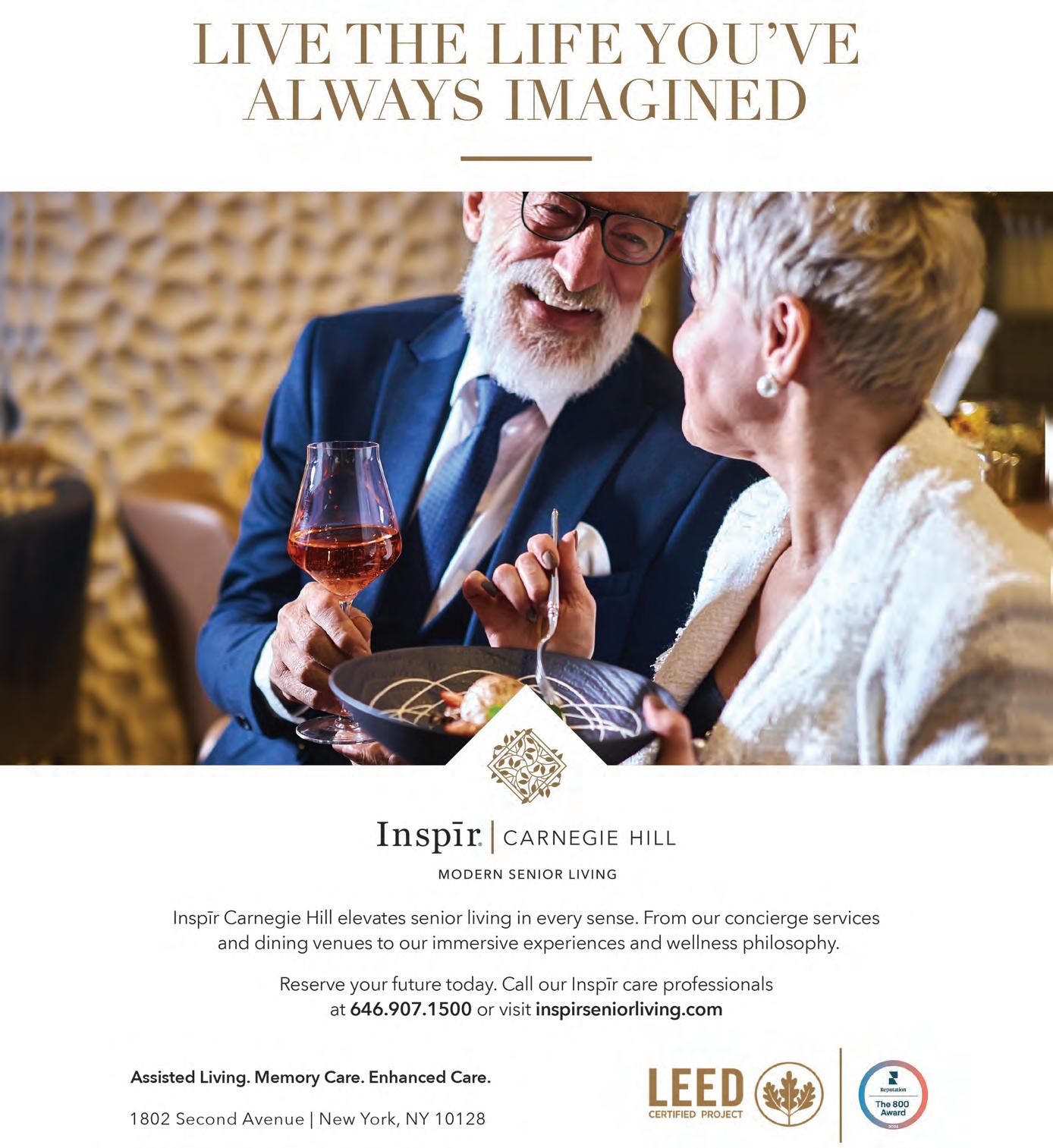

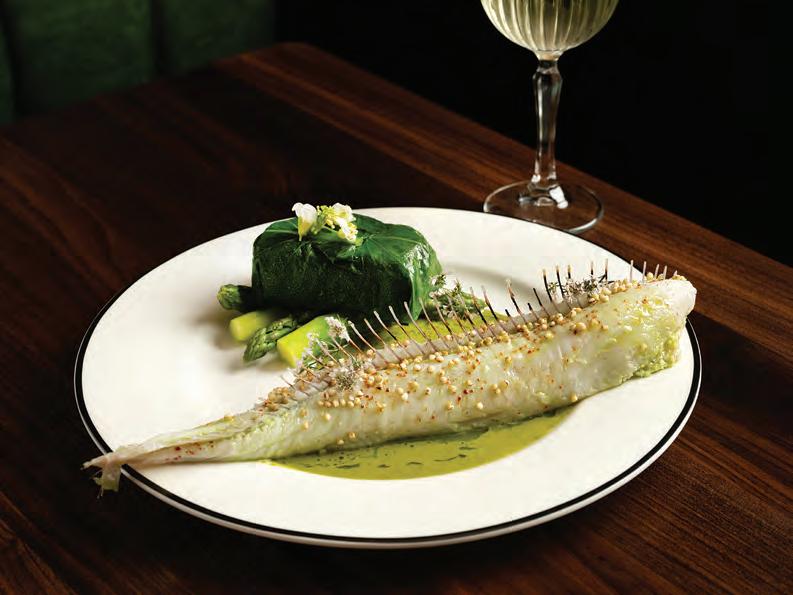
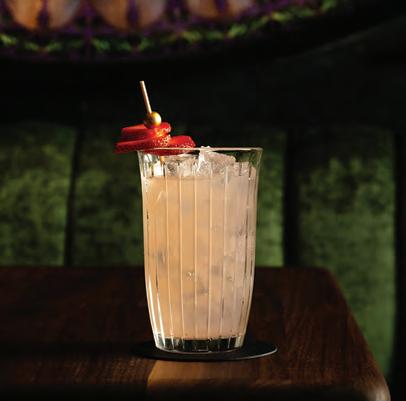
adventurous, there is a perfect steak au poivre and dover sole with smoked asparagus, pea leaves, and ramps emulsion. The chocolate bombe is a popular desert but the seven herbes cake, both sweet and savory, is the hidden star.
The bar starts to fill up with more off-duty models and the people that love them (and buy them drinks). Maison Nur’s cocktails are by Charlotte Voisey, who has worked with Khan before and was named Wine Enthusiast’s Mixologist of the Year. “The cocktail program is an homage to delicious, elegant cocktails that seamlessly enhance a great night out—delightful on their own
Maison Nur feels sexy and secretive, like a private club with a password.
and nicely complement chef Farnabe’s culinary offerings,” Voisey explains. Voisey’s cocktails are perfectly named for a Nur Khan establishment from “Beautiful People” (rose wine, passionfruit, fresh lime, and tamarind) to “Last Days of Disco” (pisco, lemongrass, fresh lemon).
Downstairs from Maison Nur is The Studio—a nightclub/lounge with a stellar sound system and cozy dancefloor. Like the mysterious, moody member’s club vibe of the restaurant, The Studio has that same insider-y feel. With a separate entrance and a young, late-night crowd, it’s yet one more jewel in Khan’s nightlife king’s crown.
A LA MAISON A dish by executive chef Richard Farnabe and cocktails by celebrated mixologist Charlotte Voisey.



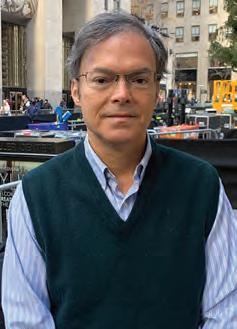

EYE ON ART
Molly Krause is an art world It Girl.

Gallery Girl
MOLLY KRAUSE is the art world’s secret weapon, the stylish social strategist behind some of New York’s top galleries—Marianne Boesky, David Nolan, and Lévy Gorvy Dayan—and exhibitions for Sotheby’s, Fotografiska, and The Armory Show. Raised all over the East Coast with deep family ties to art world royalty—her husband, Henri Neuendorf, is the son of legendary dealer Hans Neuendorf, founder of Artnet—and a force in arts patron circles (she co-chaired Storm King’s young patrons group and serves as co-chair at the Whitney Contemporaries).
JANET MERCEL meets the art world star who bridges the worlds of heritage and new blood.

Art is in your DNA. Your husband, Henri Neuendorf, continues the legacy of his father’s gallery. You must talk art all day long.
We do—and it’s not even annoying. We met in 2016 at Art Basel Miami, at a Ritz-Carlton party. He was a writer for Artnet, I was a publicist. We were in Paris together two weeks later, and I asked him to be my boyfriend. That was it. After that, we were just together.
ANDY WARHOL. Reel Basquiat. Acrylic and silkscreen ink on canvas
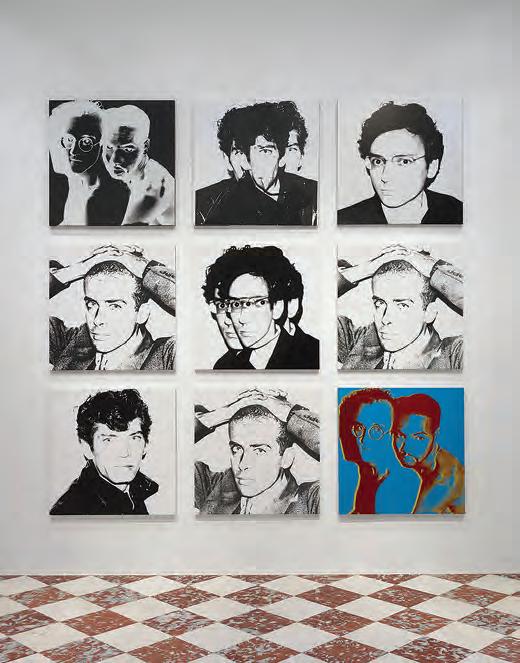
Have you always had your eye on art?
Even when I was little, I was aware of optics— how things are presented—and coming up with creative ways to show them. I remember doing a tourism project in 3rd grade on Oklahoma City. One girl in my class presented a feature on the city bombing. I remember thinking, that’s a terrible idea, why would you focus on that? Of course, when you’re a kid you don’t know what a publicist is called or that it’s a job.
“The art world has the philosophy that when things are down, it’s time to bet. It’s not time to pull out. You go full throttle. You buy. You throw the elaborate, full-on exhibition.”

You understood crisis management in the third grade.
Whenever people ask me if I do crisis comms, I say, well, if I’m any good at my job, you’re not going to know. I was doing internal communications for The Armory Show in 2020 during the earliest days of the pandemic, and we were still arguing about whether to call it Covid-19 or the coronavirus. We say in the industry, “It’s PR, not the ER.” You can’t control everything, but you can control, to some degree, how it’s perceived.
CULTURE VULTURE
Left: multiple works by Andy Warhol; right: Krause at an art event in New York.
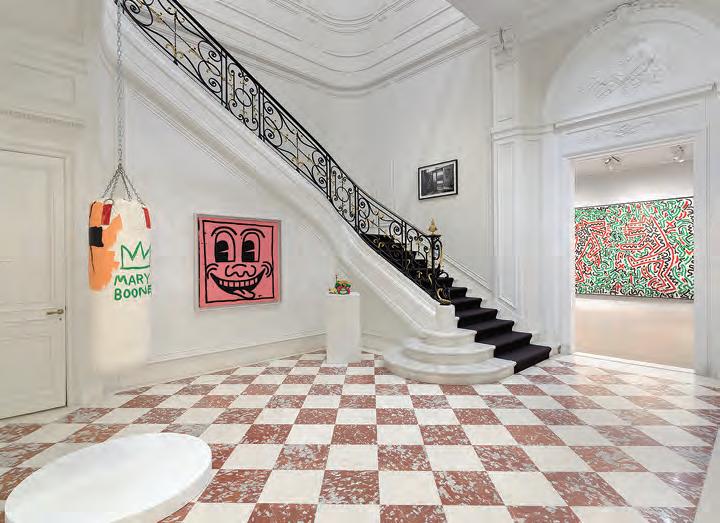
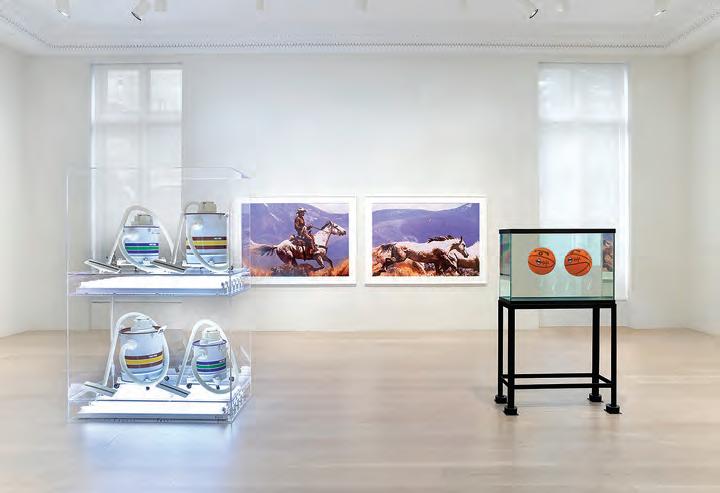
The art market has been shaken up lately. Galleries like Kasmin, Clearing, and Blum closed their doors. The Art Dealers Association of America’s show was cancelled this summer.
The art world has the philosophy that when things are down, it’s time to bet. It’s not time to pull out. You go full throttle. You buy. You throw the elaborate, full-on exhibition. Now, if you’re a gallery operating at a price point that doesn’t align with the footprint you’re taking up, maybe you have investors that will save you. If you’re a gallery that mistreats your artists—and I have plenty of friends whose galleries did, without caring how it looked or if they got caught—it’s harder to have sympathy.
Works at the Downtown/ Uptown: New York in the Eighties exhibition at Lévy Gorvy Dayan. From September 18 to December 13, 2025.
You’re a woman in the male-dominated art world.
Two of the galleries I work with have women’s names on the door—and it’s not easy to be a woman gallery principal. They’ve been maligned in the art world for as long as it’s existed.
Marianne Boesky has openly talked about the stigmas against women in the industry— especially pregnant women and mothers. Mary Boone is another woman famously torn down by a male art world. At Lévy Gorvy Dayan this fall, we have a major exhibition with heavyhitter artists of the 80s. Mary was an iconic part of that scene. For Brett [Gorvy] to initiate a collaboration with her made total sense.
Your personal and work life are intertwined.
They’re inextricably linked. I’m booking a venue for the next social event for The Whitney Contemporaries, basically a happy hour for community building within the young arts community. People join young patron’s groups to support something, but also because they’re new to New York, or they want to meet people. A very wise young patron friend said to me, “Just show up. Go to the thing. You’re never going to regret meeting people.”
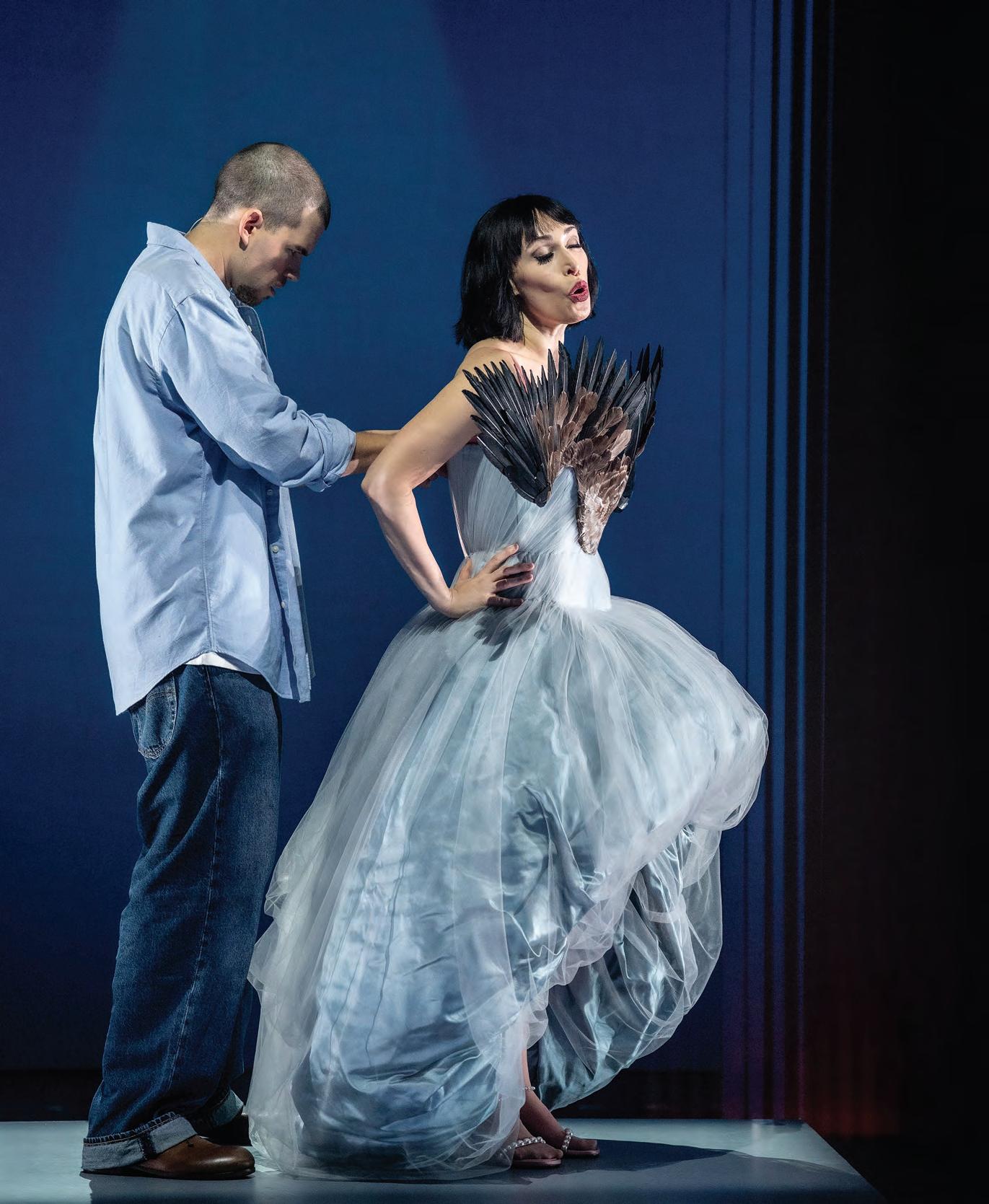
Enter the House of McQueen
Bridgerton heartthrob Luke Newton plays the late, great fashion designer Alexander McQueen at the Mansion in Hudson Yards.
JANET MERCEL pulls up a seat.
House of McQueen, about the fashion legend Lee Alexander McQueen, who hanged himself in 2010, just opened at The Mansion at Hudson Yards. Luke Newton plays McQueen, straight off starring in the latest season of the soapy series Bridgerton. With his head shaved, baggy denim and an East End slur, Newton is unrecognizable from his Bridgerton regency hero with melting manners and a waistcoat. It’s uncanny, eerie, and almost creepy, until Newton breaks into one of McQueen’s silly, awkward, boyish smiles to release the tension.
PHANTOM THREAD Luke Newton as Alexander McQueen and Catherine LeFrere as his muse and champion, the late Isabella Blow.

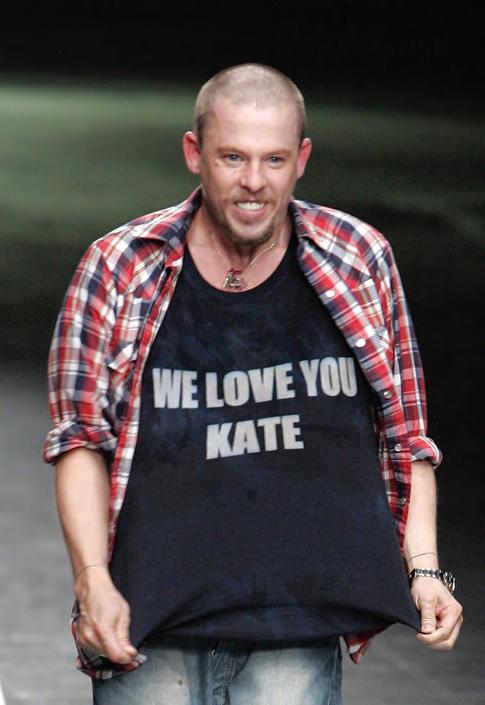
“He wasn’t afraid to explore the darker side of beauty.”
—Luke Newton
House of McQueen is the first-ever performance at The Mansion. I didn’t know what to expect. I only recently stopped assuming anything at Hudson Yards meant the mall. The Mansion feels like a proper Off-Broadway venue–on a nondescript side street, a steep theater with 499 seats (albeit with 1,000 square feet of LED screens).
There are lots of lights and sounds, but it feels right in a two-hour show intent on recreating the chaos of McQueen’s own fashion spectacles (dance marathons, asylum themes, a robot spray painting Shalom Harlow) that mirrored his exhaustion, suffocation and overstimulation. The darkness that chased him all his life: childhood abuse, homophobia, classism, snobbery from those who only accepted him once he changed his teeth, his weight, his pants—is here too.
Newton fell deep down a rabbit hole of McQueen documentaries and interviews; so much of the designer’s life was captured on film that there is no shortage of material. “McQueen represents fearless creativity,” Newton says. “He wasn’t afraid to explore the darker side of beauty or to show strength through vulnerability.” Newton also turned to playwright Darrah Cloud and her exhaustive research that made her the cast’s Lee-whisperer. “It’s about carrying on a legacy while also finding space to bring in my own perspective,” Newton explains. “There’s a responsibility in representing such a strong visionary, but within this piece of theatre, I’m inspired to keep growing and to honor creativity at its boldest.”
The play took over a decade to reach the stage. The creative director is McQueen’s nephew, Gary James McQueen, who worked alongside his uncle as head of menswear textiles. As a teenager, Gary had much in common with Lee: a turbulent home life, a love of horror films, and a habit of sketching to escape. Gary created the chrome skull on the cover of Savage Beauty, The McQueen hardbound book for The Metropolitan Museum of Art exhibition.
The show feels trustworthy, through McQueen’s complicated relationships with men and women (each of whom loved him “best”), his beloved sister’s struggle to grasp his artistic license through the viscera and violence of his collections, and his codependency with his first champion, the fashion icon and editor Isabella Blow (who also took her own life in 2007). Newton shows McQueen’s crushing pain trying to explain that he doesn’t hate women at all; he’s just realistic about their existence on earth. He wants to protect them, make them warriors.
MCQUEEN FOR TODAY Luke Newton as designer Alexander McQueen (above); the late designer after a runway show.

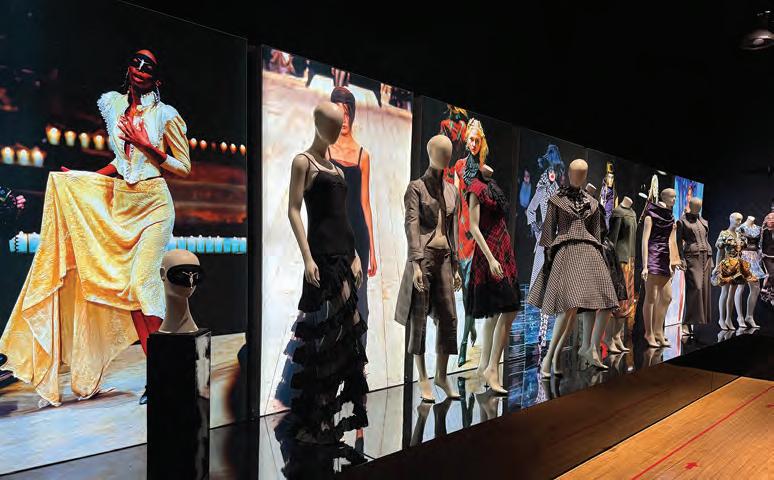
“It’s about carrying on a legacy while also finding space to bring in my own perspective. There’s a responsibility in representing such a strong visionary.”
—Luke Newton
One of my favorite moments is the recreation of McQueen’s 2004 interview in The Guardian with his mother, Joyce McQueen, played by Tonynominated actress Emily Skinner of Billy Elliot and Prince of Broadway. Originally commissioned by Sam Taylor-Wood, it’s reimagined as a television broadcast. It perfectly captures the banter between mother and son:
Joyce McQueen: Success has brought you financial security. But if you lost it all tomorrow, what would be the first thing you would do?
Alexander McQueen: Sleep. I’d be pleased.
Joyce McQueen: I said you’d go on holiday.
Alexander McQueen: What with? I’d lost it all!
One last gift to the audience: Andrew Bolton, The Met curator who famously perpetuated McQueen’s immortality with Savage Beauty. Bolton was already working on an exhibition featuring McQueen with other designers. He pivoted to a solo retrospective immediately after the designer’s death in order to save his archives from being disbanded. In that spirit, The Mansion has a show of McQueen archives, each carefully preserved in private collections throughout the years and many on display for the first time. There are over 30 pieces from McQueen’s most iconic collections ranging from 1995–2010, including Dante (FW 1996), Widows of Culloden (FW 2006), and Plato’s Atlantis (SS 2010).
Cody Braverman, Emily Skinner, and Jonina Thorsteinsdottir
FASHION FABLE Cody Braverman, Emily Skinner, and Jonina Thorsteindottir in House of McQueen, an exhibit of Alexander McQueen’s designs on display at The Mansion.





Tatiana von Furstenberg
In her graphic-novel-cum-memoir My Sunburned Summer, Tatiana von Furstenberg returns to 1987. With the delicate, dreamlike drawings of Jessika Wood, von Furstenberg becomes 14-year-old Augusta, who discovers her father is gay while on summer vacation. – Peter Davis
CHILD’S PLAY The author as a young girl.

My Sunburned Summer feels cinematic.
I wrote it as a script. The artist Jessika Wood, who I collect, is incredibly expressive, sensitive, and very emotionally complex. Her art kind of stays young. I had this idea to take my script and direct her. I would assign drawings, and enact them with visuals, photographs, wardrobe, décor, and body language. There are over 600 drawings in the book. The pictures were on little scraps of paper napkins. She's very eccentric. We laid it out like contact sheets—it was like editing a movie.
A lot happens for Augusta on summer vacation in the Mediterranean.
It's a traumatic two weeks for the whole family. The family breaks apart, and then Augusta brings them all together again. While she's in the hospital, Augusta wishes she had a pen and a paper to sketch her way out. That’s my process too. I make sense of things by writing my way through them. I wanted the book to be like a sketchbook, like somebody's diary that you found in a flea market. A secret story.
Augusta is totally you.
It's completely inspired by the truth. Summer vacations were spent with my dad and brother. We would go to Mykonos or Capri. My dad and I were only ever together on vacation, we never lived together. But it felt like we traveled the whole world as one. Almost all of Augusta is me and almost all of Leroy is my dad.
I wish your father [Egon von Furstenberg] had been able to read the book.
He would've loved it. My dad had a lot of respect for my writing. We share so much. I felt like him physically—we had the same gap teeth, the same smile, and the same mischief. The book is like looking through my favorite summer vacation snapshots and entering them. Creating it was a way to spend more time with my dad again.
JOURNALING
JOURNEY von Furstenberg’s graphic memoir takes place on a summer vacation when she was a child.


“I wanted the book to be like a sketchbook, like somebody's diary that you found in a flea market. A secret story.”
—TATIANA VON FURSTENBERG
You’ve directed a movie [Tanner Hall], cut an album [Playdate], written a graphic memoir, and curated the art show On the Inside, which advocated for those who are incarcerated.
My mom thinks I'm an installation artist. She might be right—I'm a storyteller. Art for me is in the making. I've never been good at peddling the art, or even necessarily wanting to. With this book, I put it out into the universe. It takes bravery to put yourself out there.

D&D BuildingDirectory
979 THIRD AVENUE NEW YORK, NY 10022
212-759-5408
ddbuilding.com
A. RUDIN 1201 arudin.com
ANCIENT & MODERN 1522 ancientandmodern.us
ARTE 911 arte.com
ARTSYLIGHTS 400 artsylights.com
ASSOULINE BOOKS AND GIFTS 101 assouline.com
ATELIERS DE FRANCE 1208 ateliersdefrance.com
BAUMANN DEKOR 518 baumanndekorusa.com
BENJAMIN MOORE 421 benjaminmoore.com
BESPOKE BY LUIGI GENTILE 1205 bespokebylg.com
CARINI LANG 1001 carinilang.com
CASTEL 715 castelmaison.com
CHARLES H. BECKLEY 1521 chbeckley.com
CHESNEYS 1119 chesneys.com
CHRISTOPHER HYLAND, INC. 1710 christopherhyland.com
CHRISTOPHER PEACOCK 6th Floor and Annex 5th Floor peacockhome.com
CL STERLING & SON 200 clsterling.com
CLAREMONT FURNISHING FABRICS CO. 1405 claremontfurnishing.com
CLARENCE HOUSE 205 clarencehouse.com
COWTAN & TOUT 1022 cowtan.com
DAKOTA JACKSON 501 dakotajackson.com
DANIEL SCUDERI CUSTOM FURNITURE 500 danielscuderi.com
DAUM 903 us.daum.fr
DAVID MICHAEL INTERIORS 612 davidmichaelinteriors.com
DAVID SUTHERLAND 401 perennialsandsutherland.com
DDB SELECT 506 and 707 ddbuilding.com
DEDAR MILANO 1009 dedar.com
DEDON 720 dedon.de
DONGHIA 1005 kravet.com/donghia
DUKE WOOD FLOORS 214 dukewoodfloors.com
ÉLITIS 611 elitis.fr
FABRICUT 915 fabricut.com
FÉAU BOISERIES 508 feauboiseries.com
FORBES & LOMAX 1207 forbesandlomax.com
FORTUNY 1632 fortuny.com
GARRETT LEATHER 1107 garrettleather.com
GLOSTER 1601 gloster.com
GRACIE 1411 graciestudio.com
GRANDE CENTRAL SHOWROOM Annex A centralplumbingspec.com/ kitchen-bath.html
HOLLAND & SHERRY 1402 interiors.hollandandsherry.com
HOLLY HUNT
NEW YORK 503 & 605 hollyhunt.com
HOULÈS 919 houles.com
HUNTER DOUGLAS 138 hunterdouglas.com
I.J. PEISER’S SONS FINE WOOD FLOORS Concourse 1 ijpeiser.com
INNOVATIONS 1717 innovationsusa.com
JAB ANSTOETZ 102 jab.de
JIM THOMPSON | JERRY PAIR 1640 jimthompsonfabrics.com
JOHN ROSSELLI & ASSOCIATES 1800 johnrosselli.com
KETTAL Annex 333 kettal.com
KOROSEAL 842 koroseal.com
KRAVET 1202 kravet.com
LEE JOFA | BRUNSCHWIG & FILS 234 kravet.com/lee-jofa kravet.com/brunschwig-fils
LORO PIANA 820 loropiana.com/interiors
LUTRON 319 lutron.com
M. ALEXANDER 313 malexanderlighting.com
MR. GLAZIER STUDIO 815 mrglazierstudio.com
MARC PHILLIPS DECORATIVE RUGS 211 marcphillipsrugs.com
MARTIN PATRICK EVAN CUSTOM RUGS & CARPETS 507 martinpatrickevan.com
MAYA ROMANOFF 922 mayaromanoff.com
MCKINNON AND HARRIS Annex 111 mckinnonharris.com
NELLA VETRINA 805 nellavetrina.com NOBILIS 512 nobilis.fr
O’LAMPIA STUDIO 300 olampia.com
OCHRE 1109 ochre.net
OSBORNE & LITTLE 520 osborneandlittle.com
PATTERSON FLYNN 632 pattersonflynn.com
PHILLIP JEFFRIES 1115 phillipjeffries.com
PHOENIX GALLERY 134 phoenixgalleryny.com
PIERRE FREY 1611 pierrefrey.com
QUADRILLE | OOMPH HOME 1415 quadrillefabrics.com
RESSOURCE HOUSE OF PAINTS 1507
ressource-peintures.com
ROGERS & GOFFIGON LTD. 1718 rogersandgoffigon.com
ROMO 808 romo.com
RONIT ANDERSON 1016 ronitanderson.com
ROSE TARLOW MELROSE HOUSE 1616 rosetarlow.com
RUG ART INTERNATIONAL 1518 rugart.nyc
SAINT-LOUIS 816 saint-louis.com
SANDERSON DESIGN GROUP 905 sanderson. sandersondesigngroup.com
SAVEL INC. 1819 savelinc.com
SCALAMANDRÉ 1002 scalamandre.com
SCHUMACHER 832 fschumacher.com
SCOTT GROUP STUDIO 411 scottgroupstudio.com
STARK 1102 starkcarpet.com
STUDIO VAN DEN AKKER 1510 studiovandenakker.com
STUDIO ZEN WALLCOVERINGS 1818 studiozenwallcoverings.com
THG PARIS 1206 thg-paris.com
TOM’S SONS INTERNATIONAL PLEATING 800 Internationalpleating.com
WALTERS 538 waltersnyc.com
WARP & WEFT 1203 warpandweft.com
WEGNER FINE CABINETRY 1811 wegnercabinetry.com
WIRED CUSTOM LIGHTING 105 wired-designs.com
WOLF-GORDON 413 wolfgordon.com
ZIMMER + ROHDE 813 zimmer-rohde.com/en
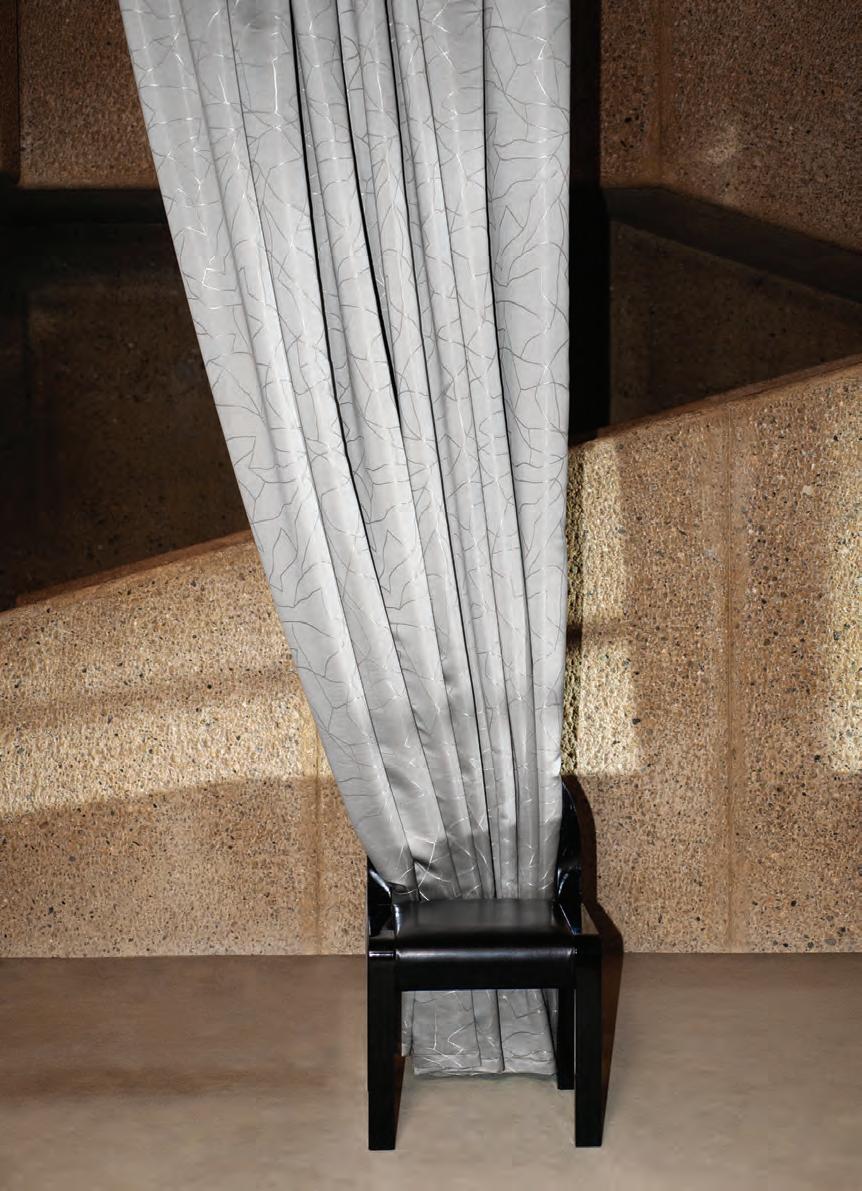

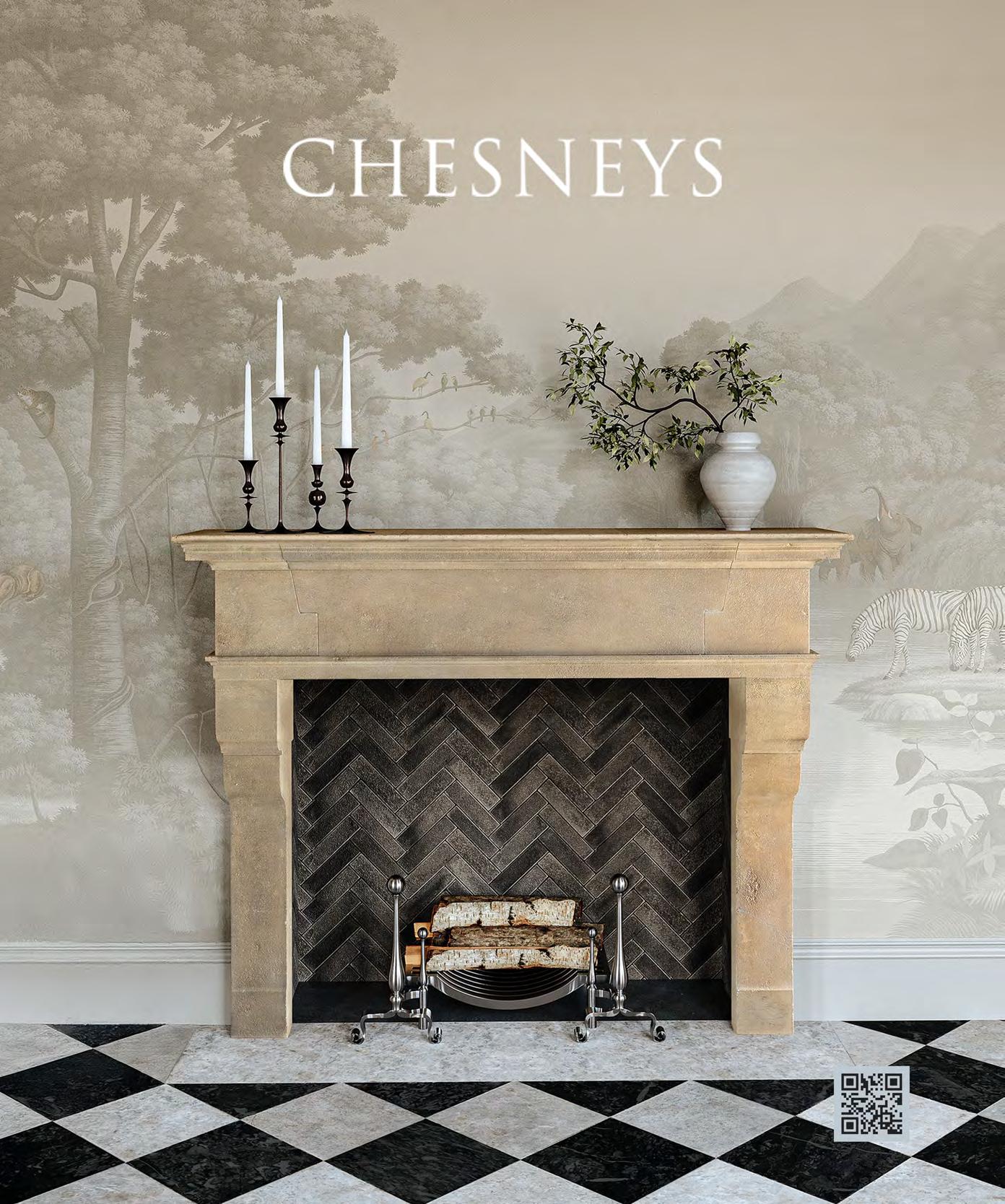
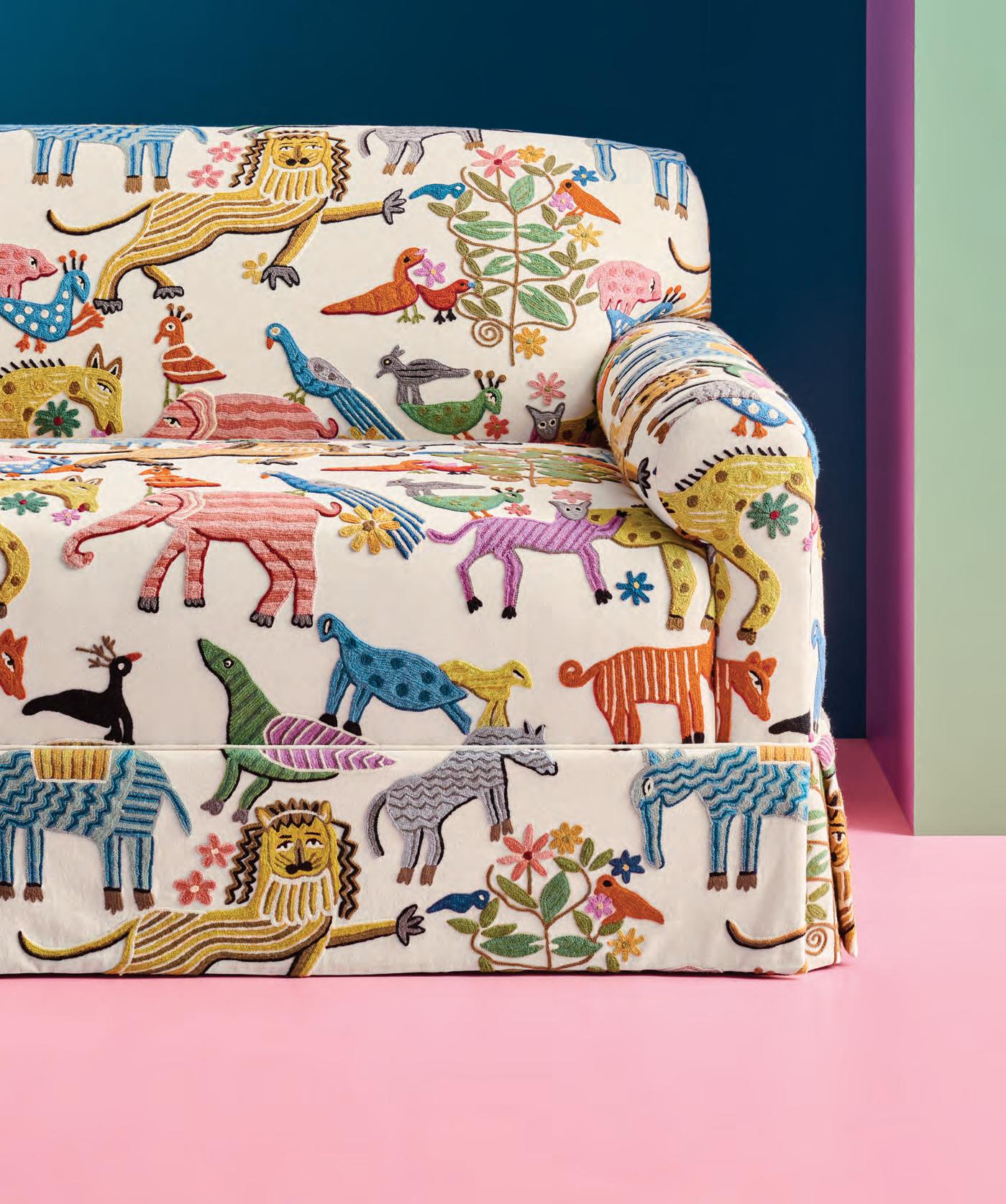




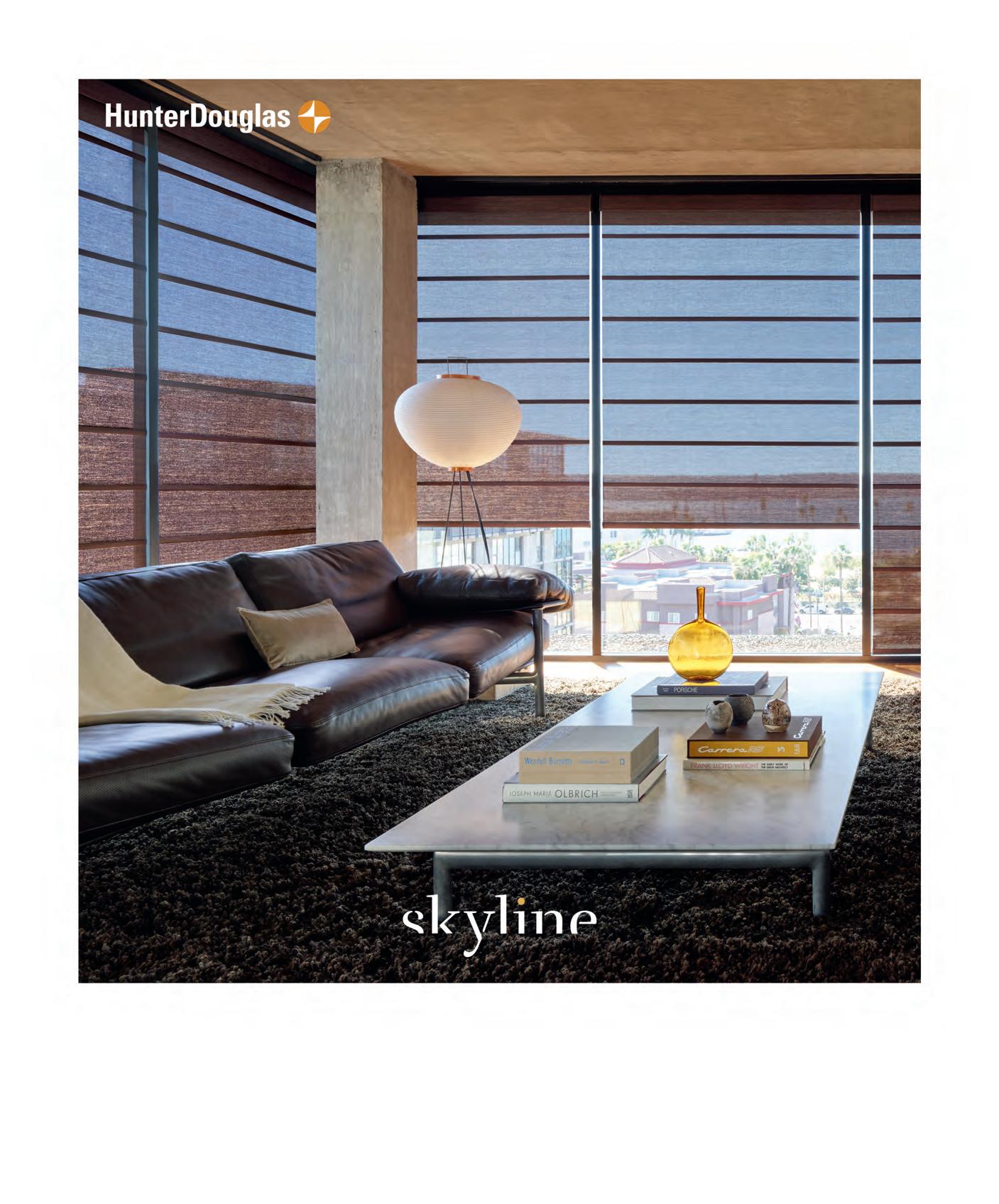













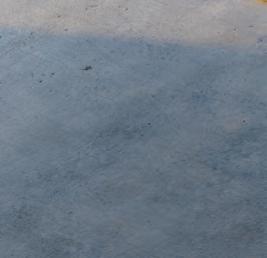
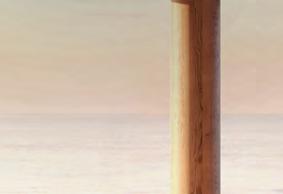




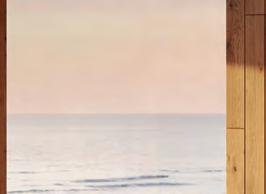









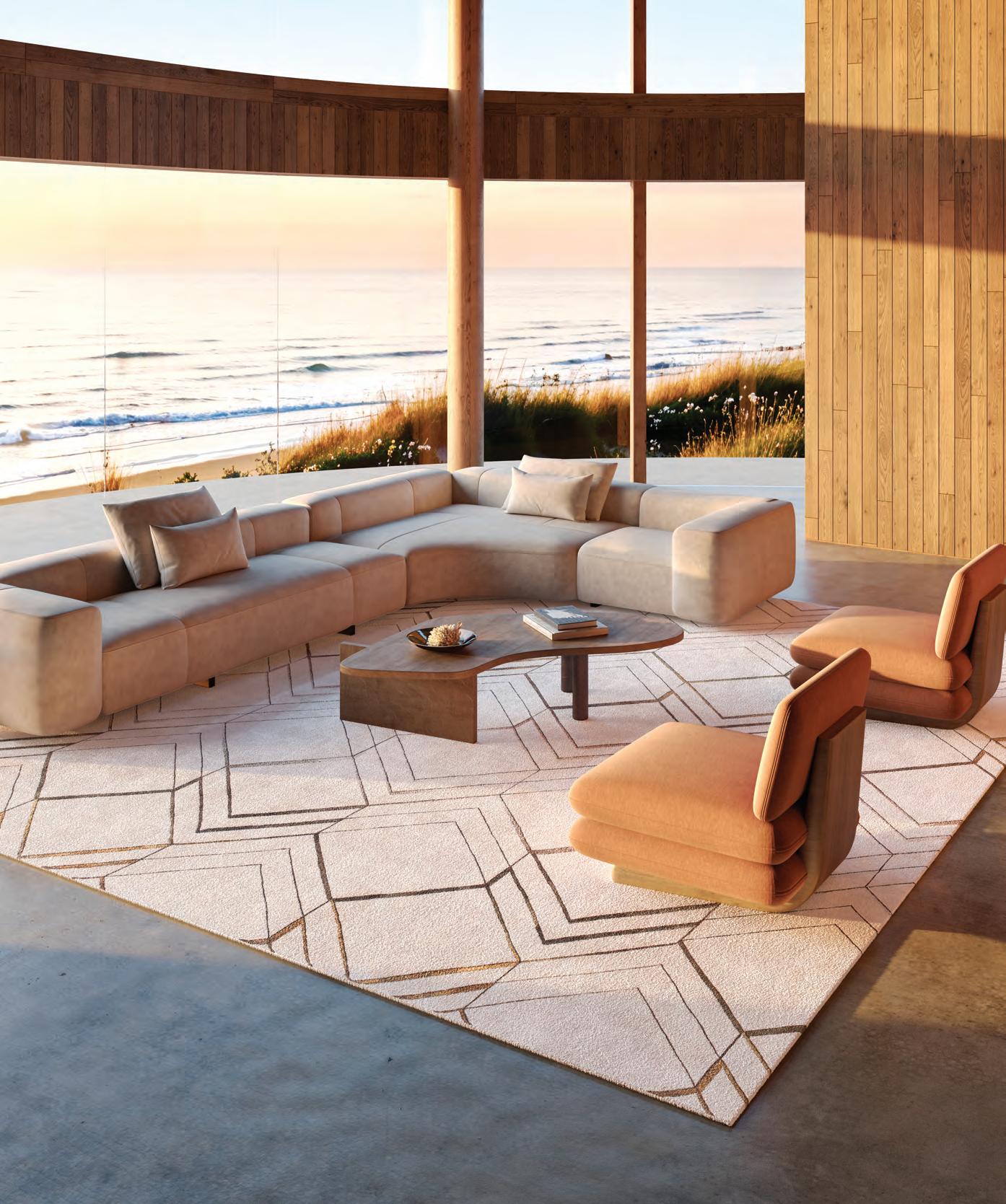



Cielo Crest on sofa and chairs.
Cielo Nimbus on trim.



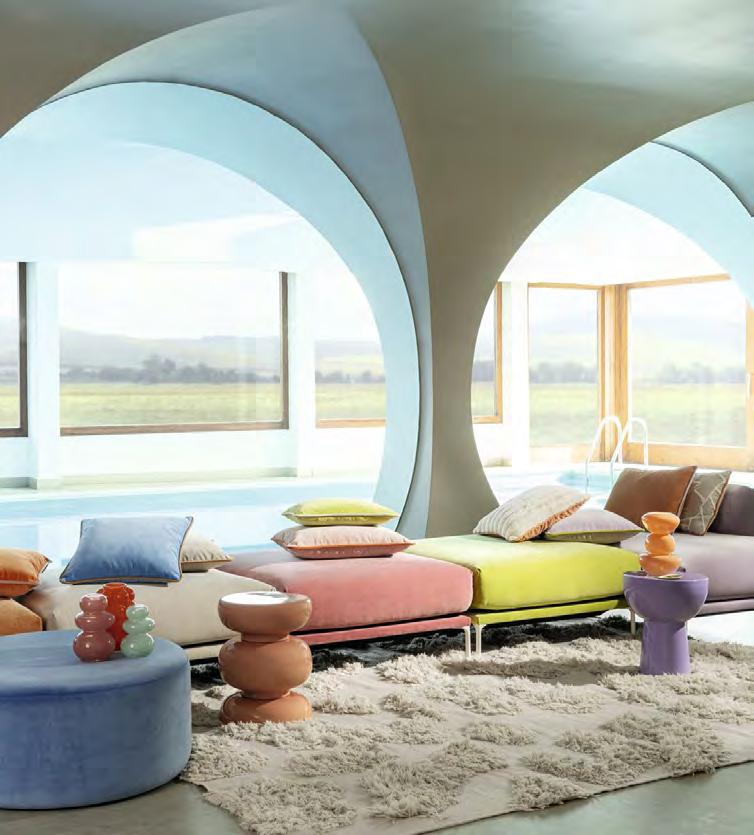
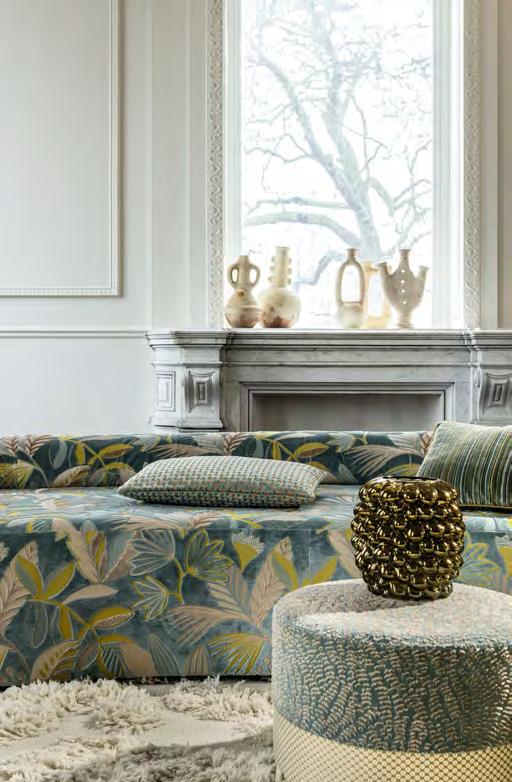


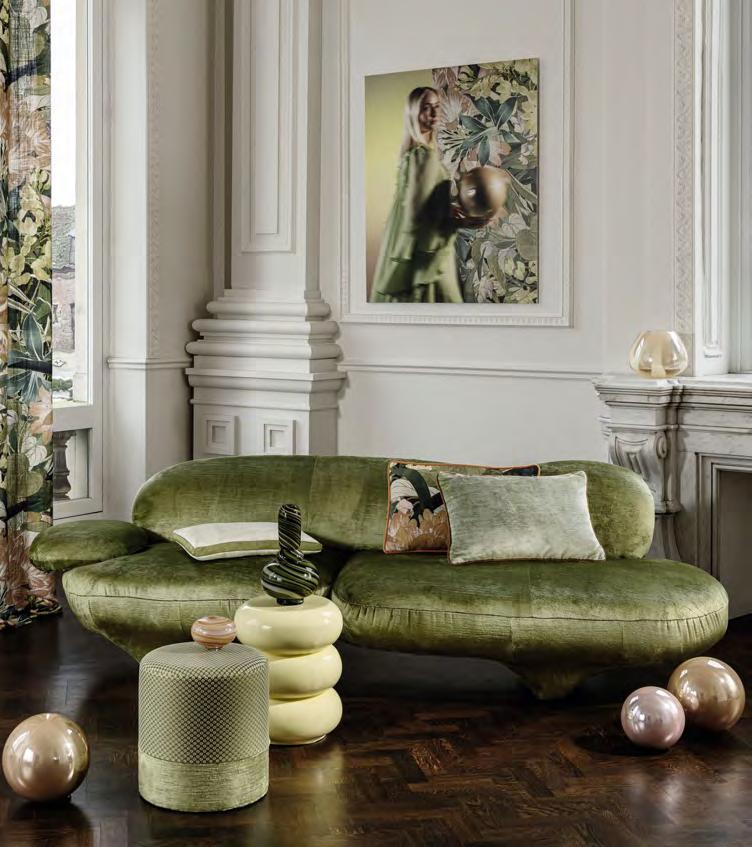




WALLPAPER, FABRIC, WALLCOVERING,
Auteur & Éditeur.
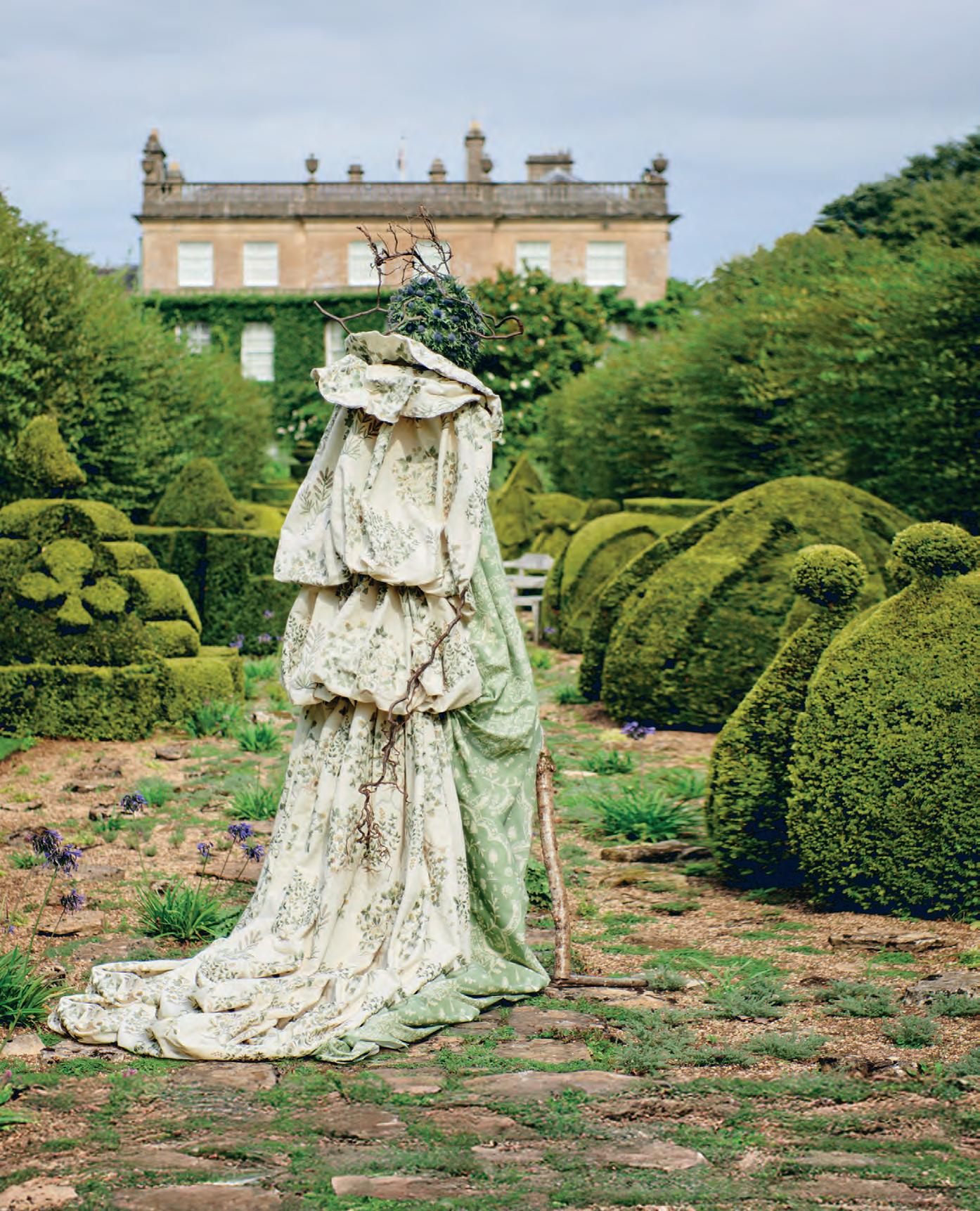

Charlotte Lucas

Rooms
AU THOR CARL DELLATORE’S FIFTH BOOK, 100 ROOMS, IS AN A-Z IN HIGH DESIGN—WITH CONTRIBUTIONS FROM STEVEN GAMBREL, MARK SIKES, BUNNY WILLIAMS, AND MILES REDD. BY PETER DAVIS
“FIRST AND FOREMOST, DESIGN IS AN EXERCISE IN PROBLEM-SOLVING. EVERY DECISION ADDRESSES A SPECIFIC NEED; PROCEED FROM THAT ASSUMPTION.”
—CARL DELLATORE
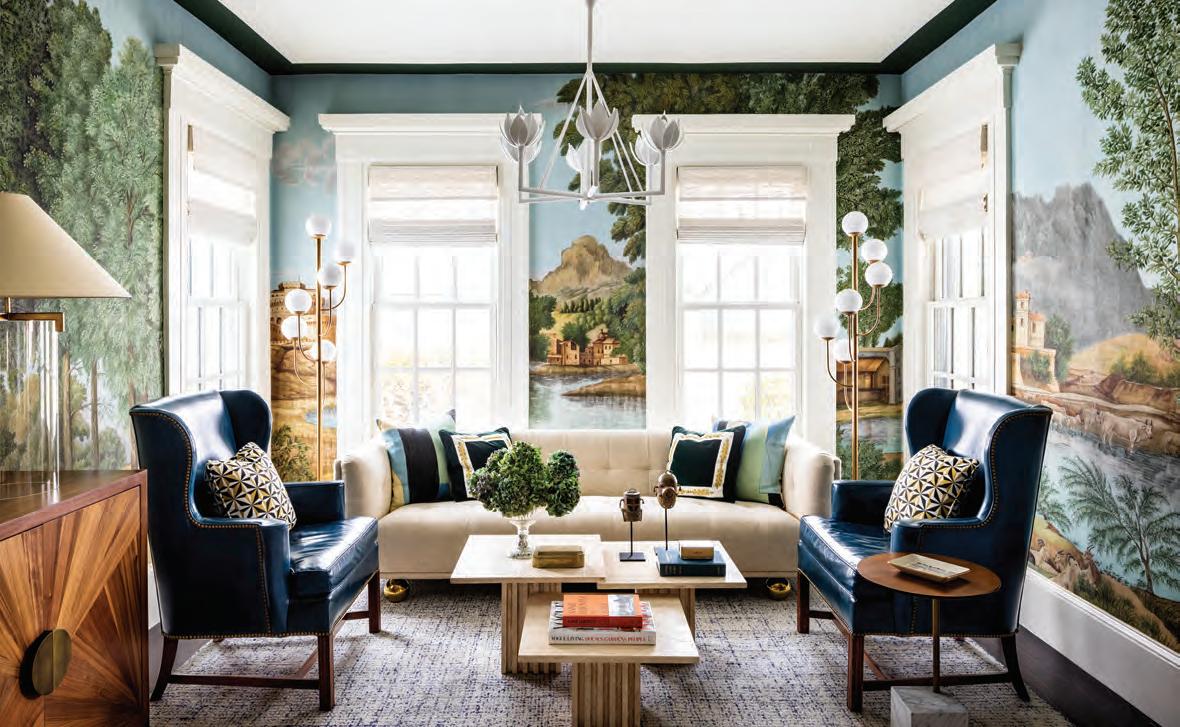

Your book is truly a master class in interior design.
First and foremost, design is an exercise in problem-solving. Every decision addresses a specific need; proceed from that assumption. Keep an open mind. There’s a famous quote from the late Wayne Dyer: “If you change the way you look at things, the things you look at change.” Be open to alternative perspectives. And listen with intent. If I’ve learned anything in producing my books, it’s that listening with intent is a virtue to be cultivated.
100 rooms–that’s a big number.
I spent a year looking at work in shelter publications, on social media, and designers’ websites. I compiled nearly 1,000 rooms in a folder, then began the editing process, which took another year. It’s a lengthy process, but in the end, the rooms in the book represent this moment in decorative arts history.
What room do you spend the most time in?
In a perfect world, I spend most of my time in
Corey Damen Jenkins

Markham Roberts

Jesse Carrier + Mara Miller
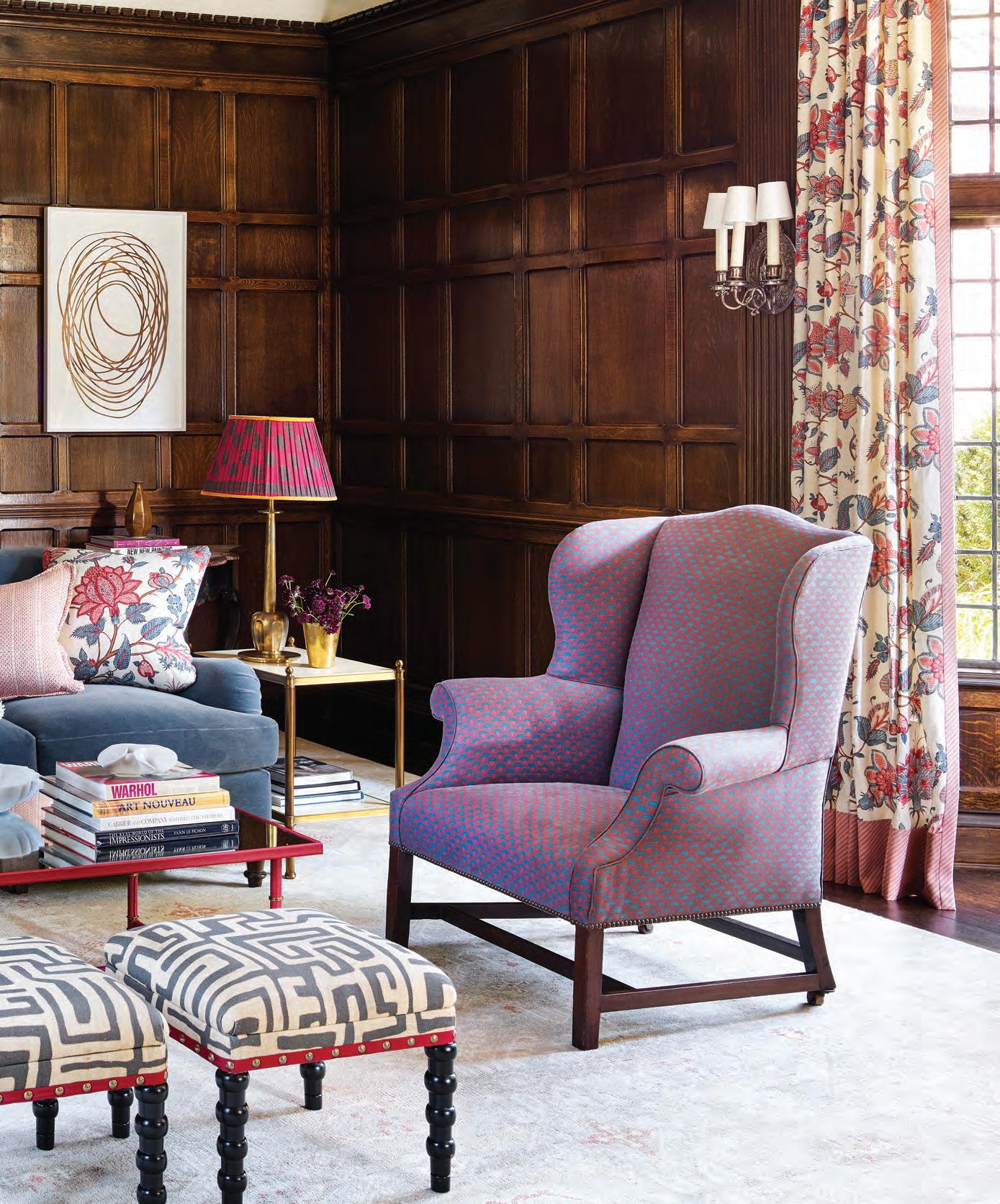
“IT’S A LENGTHY PROCESS, BUT IN THE END, THE ROOMS IN THE BOOK REPRE SENT THIS MOMENT IN DECORATIVE ARTS HISTORY.”
—CARL DELLATORE
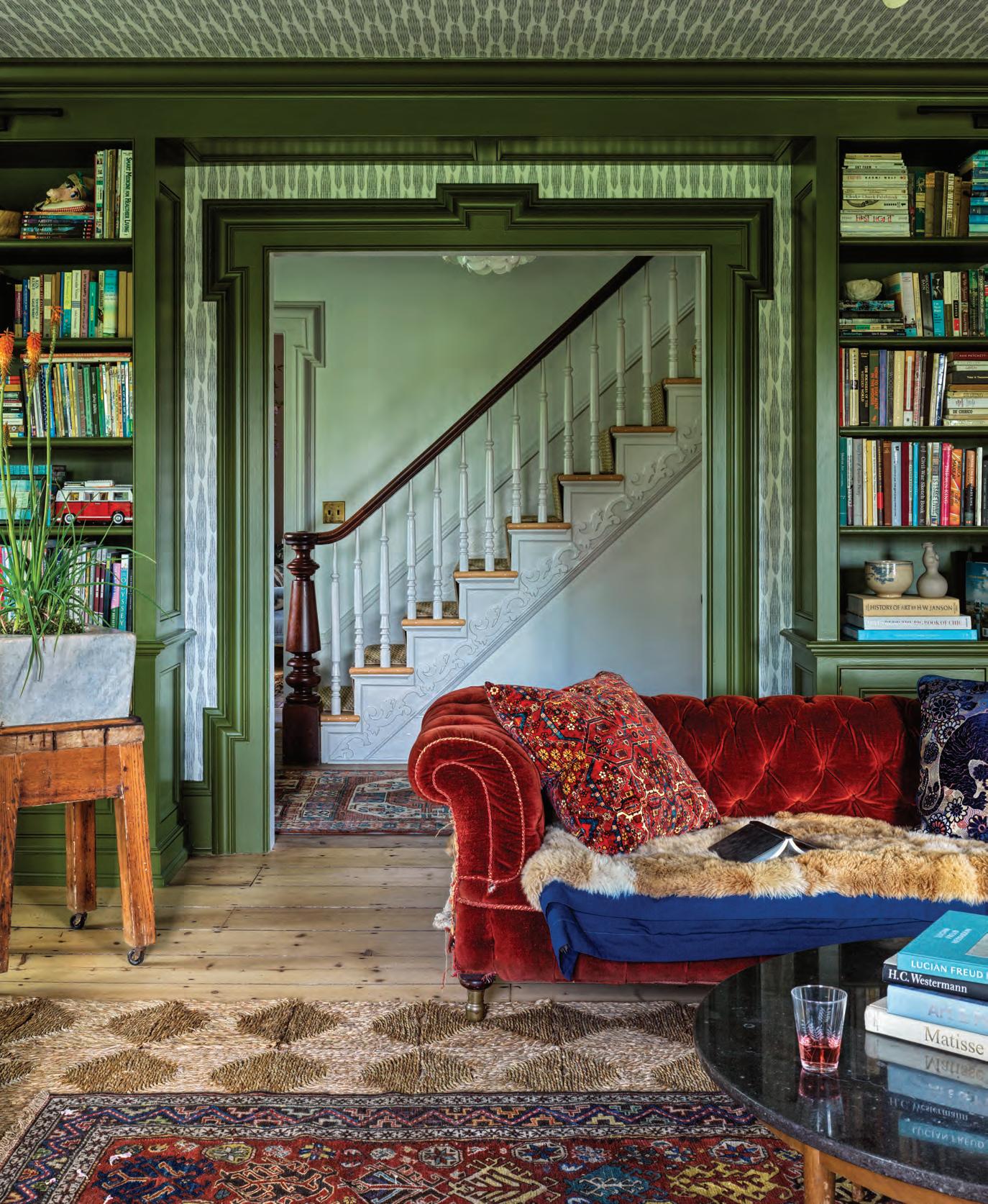
Heide Hendricks + Rafe Churchill
“I SPEND AT LEAST AN HOUR ON INSTAGRAM EVERY DAY, AND IT CONSISTENTLY INFORMS MY BOOK WORK.”
—CARL DELLATORE


the kitchen. Besides my work in design, I can think of nothing I enjoy more than cooking. Several years ago, I took up making homemade pasta—something my Italian grandmother did every Sunday. It’s incredibly meditative.
Carl Dellatore & Associates helps others produce amazing books.
Several years ago, a designer whose work I admire asked me to help him organize a book proposal, which was later purchased by a well-known publishing house. It was an organic progression to do that work; having the experience of creating five books for Rizzoli helped inform that skill set. I’m busy working with several other designers now, which is great fun.
There is so much design eye candy on social media.
I know designers who have built entire businesses from their Instagram feeds, which is quite remarkable. I spend at least an hour on Instagram every day, and it consistently informs my book work. I approach my Instagram from a less-is-more perspective. I prefer to share quality images/posts over quantity.
Left: Summer Thornton; right: Ghislaine Viñas
100 Rooms by Carl Dellatore is available September 2, 2025 by Rizzoli International Publications.
FÉAU BOISERIES, PARIS’ HISTORIC HOUSE OF BOISERIES
OPENS IN NEW YORK
BY TED HILDNER
Treasure Trove

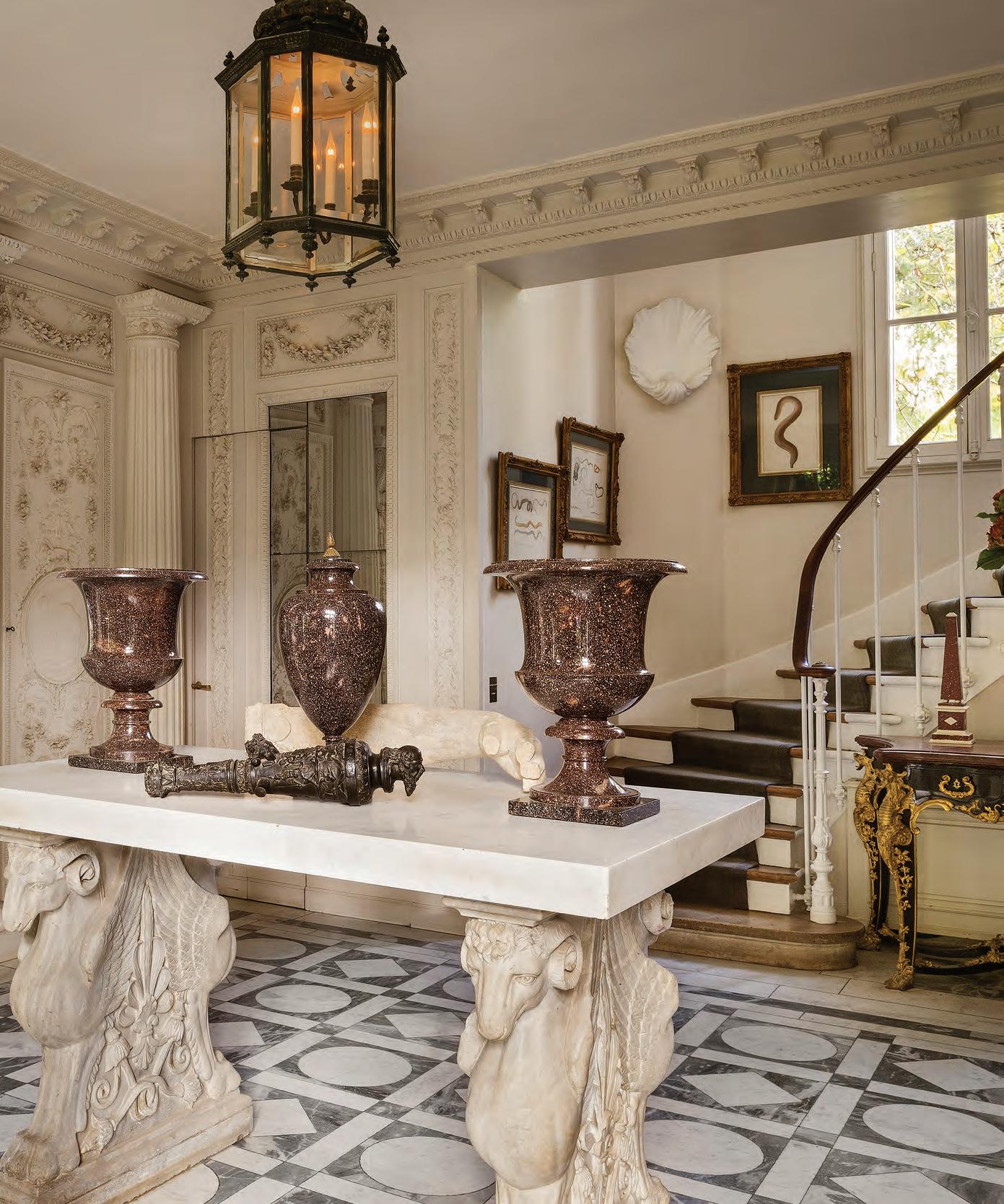


Since 1875, the atelier Féau Boiseries has been carving its place in history, as the go-to for aristocrats, collectors and designers for exquisite boiseries and wood paneling. Boni de Castellane used Féau for his opulent Palais Rose in Paris as did the American industrialist Henry Clay Frick who used Féau’s gilded boiseries when building his Fifth Avenue mansion.
Féau’s first showroom outside Paris marks a milestone for a house that’s spent 150 years shaping some of the world’s most iconic interiors. The atelier has amassed an enormous archive of panels, moldings, fireplaces—an architectural treasure trove that spans centuries. “Our Paris showroom is really a 25,000 square foot workshop. It’s a maze of rooms that flow into one another like a treasure hunt,” says Guillaume Féau, who runs the family firm. In Paris, you’ll find fully reconstructed interiors, loose panels
of every scale, style, and condition and one of the world’s largest collections of carved, painted, and gilded boiseries from the 18th to the 20th century. “I spent my childhood playing hide and seek with my family there,” says Leopold Féau, who’s part of the 4th generation who relocated from Paris to run the New York outpost with Féau CEO Anthony Fournier.
Recreating the Paris atelier was never realistic so the family took their time picking a second home. With international demand, Guillaume & Leopold ultimately recognized the importance of the D&D Building, making it the obvious spot to open Féau’s first overseas showroom.
Féau’s New York showroom is like a visit to a very chic little museum. With paneled interiors and highly styled vignettes, the space presents the house’s greatest hits from the 17th century until today,
Karl Lagerfeld relied on the workshop for his reinterpretation of the Hôtel de Crillon and designers Peter Marino and Michael S. Smith continuously commission custom work for their projects. “We designed the space to be an immersive experience, with fully assembled replicas of our most iconic rooms and plenty of samples to touch and examine, and lots and lots of stories,” says Leopold.

Féau’s first showroom outside Paris marks a milestone for a house that’s spent 150 years shaping some of the world’s most iconic interiors.



“It’s a maze of rooms that flow into one another like a treasure hunt.”
—GUILL AUME FÉAU
With international demand, Guillaume & Leopold ultimately recognized the importance of the D&D Building, making it the obvious spot to open Féau’s first overseas showroom.
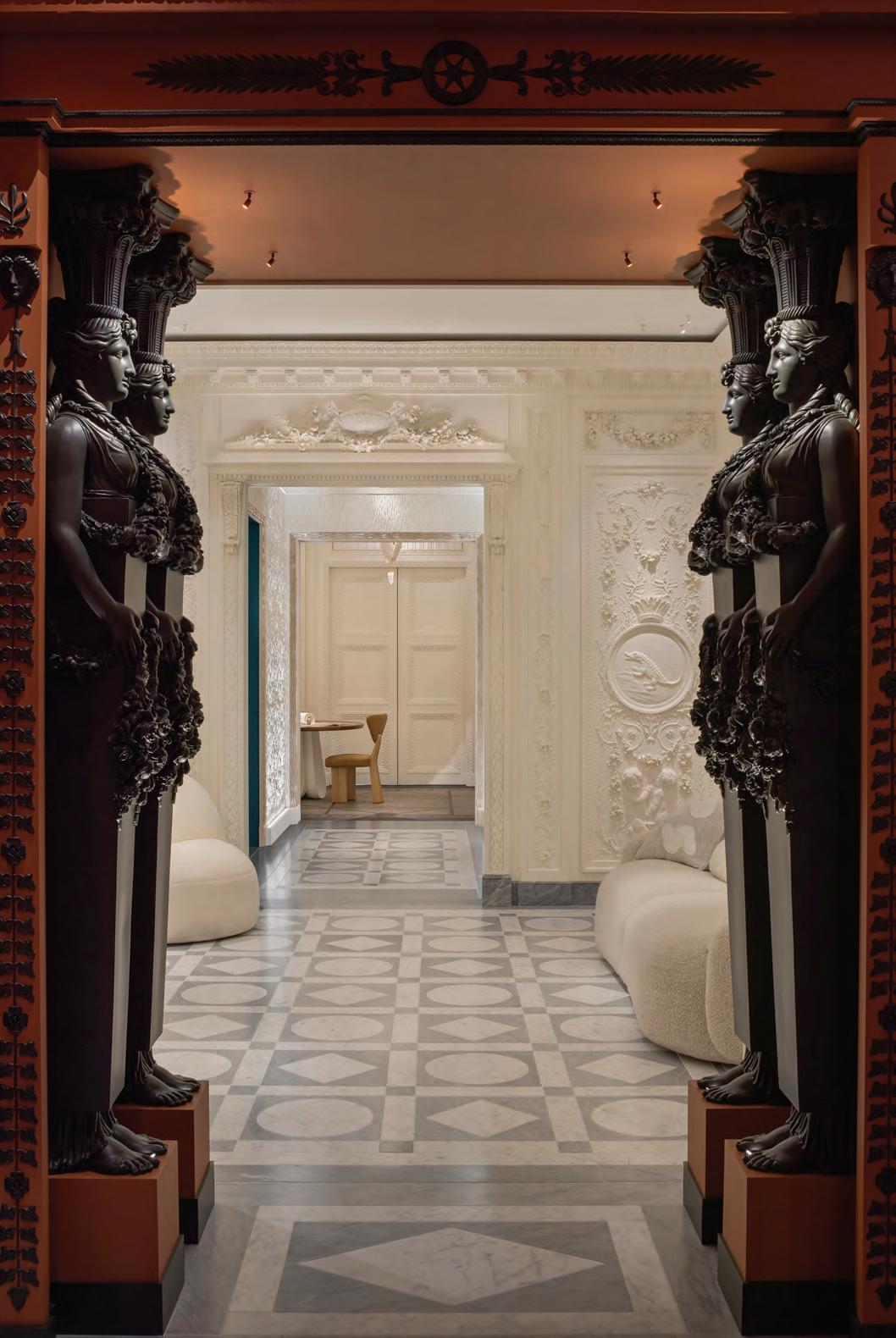

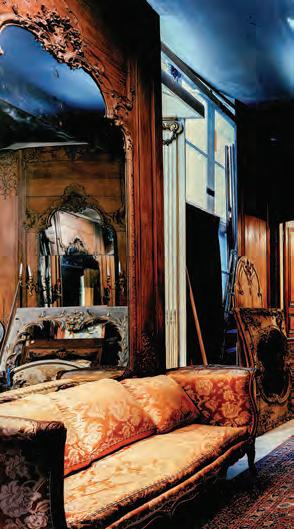



Lisbon has never been more fun or more stylish. JANET MERCEL meets Miguel Guedes de Sousa and his wife Paula Amorim, the brains behind Portugal’s style revolution.
Portugal's Social Empire: The JNçQUOI Universe
The first hint that the JNçQUOI hospitality concept (elusively pronounced je ne sais quoi) plays in another league comes at the Lisbon airport. It’s not the Range Rovers or the futuristic glass ampoules of ginger-bright elixir that I crack open like a vitamin shot from Jupiter. It’s that I never see the airport at all. I’m met on the tarmac and taken to a plush room. Someone casually requests my passport, as though it’s an optional afterthought. Ten minutes later, we glide away in an SUV.
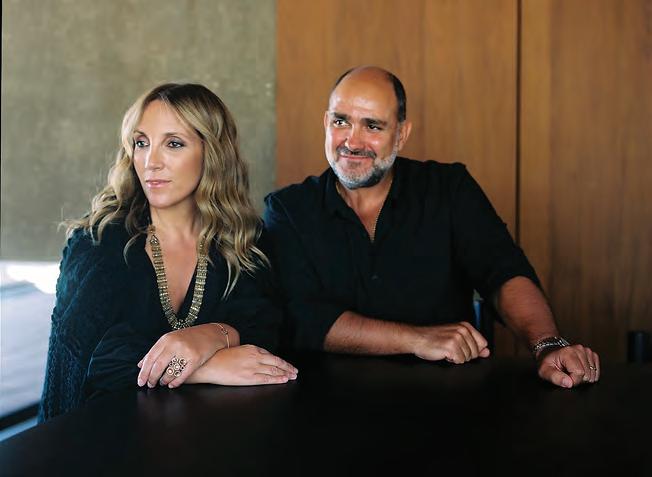
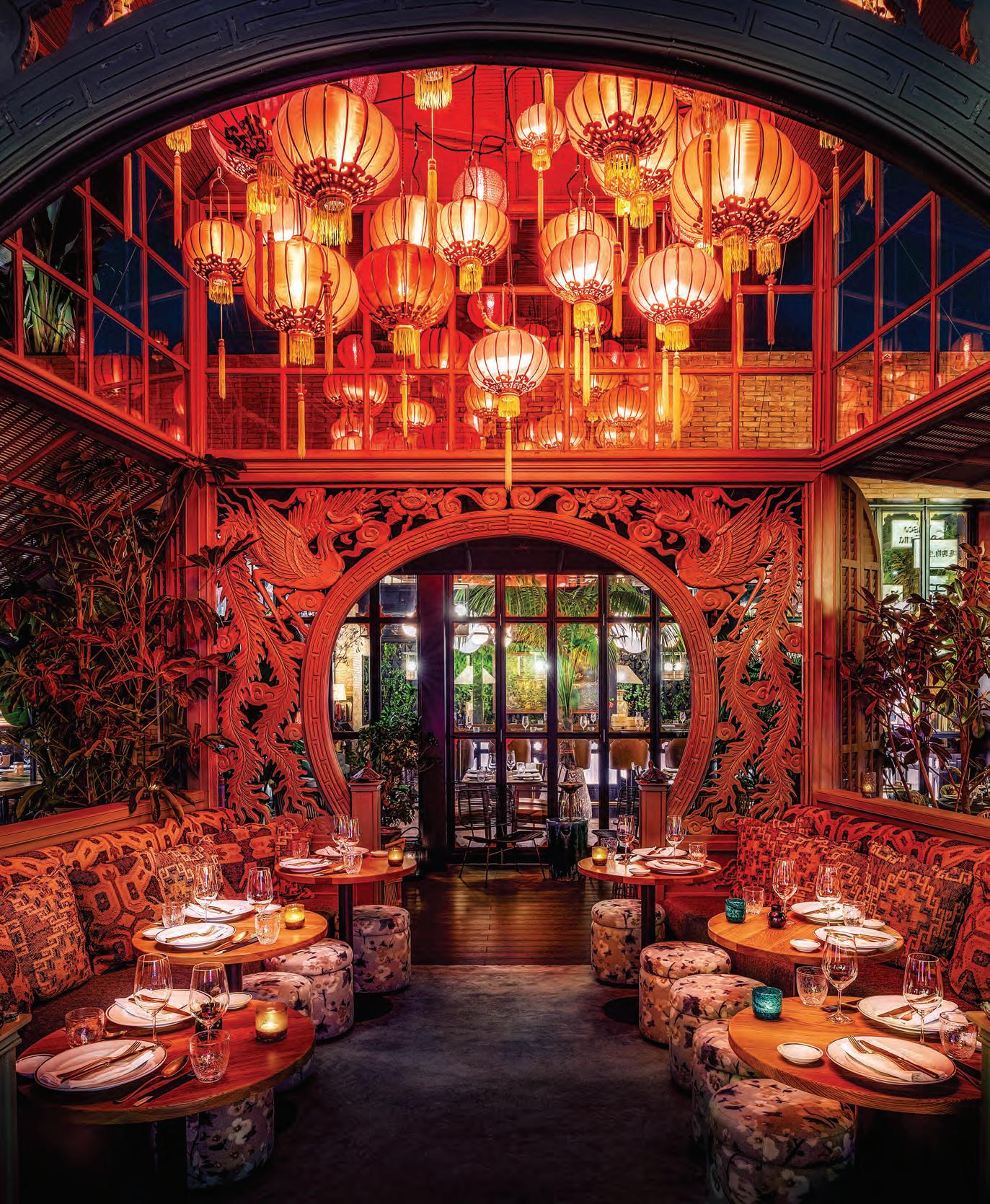
“Old world meets new fashion. JNçQUOI aims to be Portugal’s social universe you might call it an empire extending from city life to beach culture.”
In moments, we’re upstairs on the balcony of the members club overlooking Avenida da Liberdade, Lisbon’s answer to the ChampsÉlysées. My breakfast overflows with papaya, raspberries, and Ovos Moles de Aveiro, waferthin, nautical-shaped Portuguese delicacies filled with custard.
JNçQUOI, a hub of restaurants, nightclubs, fashion and interiors boutiques and soon, hospitality–is the red-hot center of Lisbon’s society scene. Next March, JNçQUOI House makes its grand debut. The project is designed by Belgian architect Vincent Van Duysen. Think old world meets new fashion. JNçQUOI aims to be Portugal’s social universe—you might call it an empire—extending from city life to beach culture, with two hubs: Lisbon and the beach club an hour away in Comporta.
"The service is like nothing I've ever seen,” says Marjorie Gubelmann, a global DJ sensation who recently moved to Lisbon from New York.

“It's the most elegant, the most fun, the most delicious. I could eat in their restaurants every night of the week.” Design star Nate Berkus tells me, “We flew in from everywhere for Marjorie’s birthday at JNcQUOI." For Gubelmann’s dinner dance, friends Tory Burch, Allison Sarofim, Neil Patrick Harris, and David Burtka arrived from all corners of the world.
Each JNçQUOI restaurant offers an entirely different vibe and cuisine. Avenida, a former theater, has soaring ceilings and a life-size
velociraptor skeleton in a glass box. You might find club members Berkus and husband Jeremiah Brent lingering with their kids. “We love a long lunch with our children,” Berkus says. “And a private party at night.”
At Avenida, I savor prawns and lobster draped in truffle mayonnaise piled so high with beluga caviar that it makes my jet-lagged head spin. Downstairs, the bar room is a glass-walled wine cage, part private tasting, part dinner theater. In a move of disco decadence, the black glitter
SASHAY SASHAY A house performer at JNçQUOI Asia.

“The black glitter terrazzo bathroom in the basement has stalls that circle a DJ booth like a surreal nightclub which, at night, it becomes.”
terrazzo bathroom in the basement has stalls that circle a DJ booth like a surreal nightclub which it becomes at night.
It’s no shocker that chic Americans are flocking to Lisbon. Interior designer Alicia Murphy moved from East Hampton a year ago.
“As a designer,” she explains, “It’s so inspiring to wake up here—the history, the light, the texture, and color. The US and the Hamptons are polished. Portugal has patina.”
At JNçQUOI, Murphy found her
community. Members’ programming is jam-packed: wine tastings, guest chefs, young members’ nights, concerts, guest DJs. “It’s the energy. And people—from Comporta and all over the world,” Murphy continues. “I bring clients and friends to lunch, and then at night we go out. I don’t want to be up until 3 in the morning, but I still want to dance.”
The wizards behind Portugal’s Oz are Miguel Guedes de Sousa and his wife Paula Amorim, who began shaping JNçQUOI two years after
JURASSIC CHIC A dinosaur skeleton commands the room at Avenida.
“For Marjorie Gubelmann’s dinner and dance party, friends Tory Burch, Allison SaroFIm, Neil Patrick Harris, and David Burtka arrived from all corners of the world.”

they married. Paula brings high fashion as an original founder and investor in Tom Ford. Miguel has the precision of luxe hospitality, having spent his career managing Aman resorts. “The club has mastered the idea of international luxury from the location to the adorable people working on the beach,” Berkus says. “We feel instantly welcomed and very much at home.”
Shopping at JNçQUOI comes in the form of Vincent van Duysendesigned “Fashion Clinics” in the city and at the beach. I find La Double J, Pucci, and Johanna Ortiz nestled next to Balmain, Gucci, and of course Tom Ford—but the star of the show is Amorim’s own house label, “Paula.” The ready-to-wear line comprises luscious silks, bold prints, and tailoring made for jet-set ease. Amorim’s interiors collection, “House
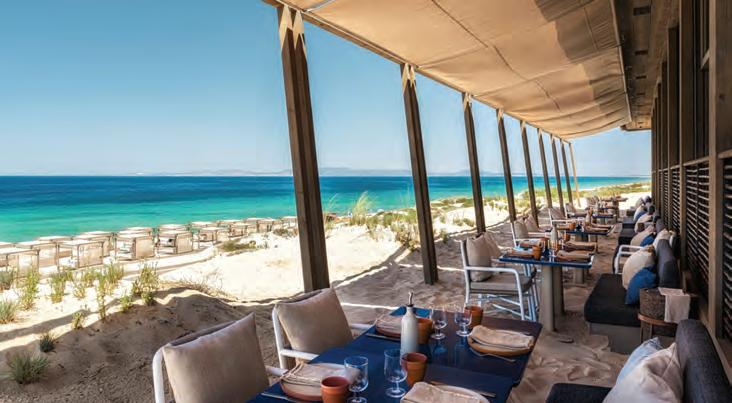
of Capricorn,” extends the same shot of glamour: embroidered Guimarães linens, richly patterned textiles, and a maximalist’s trove of Portuguese porcelain and silver. Touches of cork are everywhere at JNçQUOI, from the salt cellar and trivet on restaurant tables to accessories for sale. Paola’s family is one of Portugal’s largest cork exporters.
We’re Miguel’s guests for dinner later at Frou Frou, a supper club and cabaret with walls fringed like a flapper’s skirt. Resident drag queens Miss Velvet and Ming croon a duet with theater-level quality Dolby sound. The now-famous Peking duck arrives in a ceramic “rubber” duckie house and gets prepared tableside. In secret, we convince our
MARJ IN CHARGE The DJ and socialite Marjorie Gubelmann hosted her birthday dinner dance at JNçQUOI. Bottom: JNçQUOI's pool and beach club.
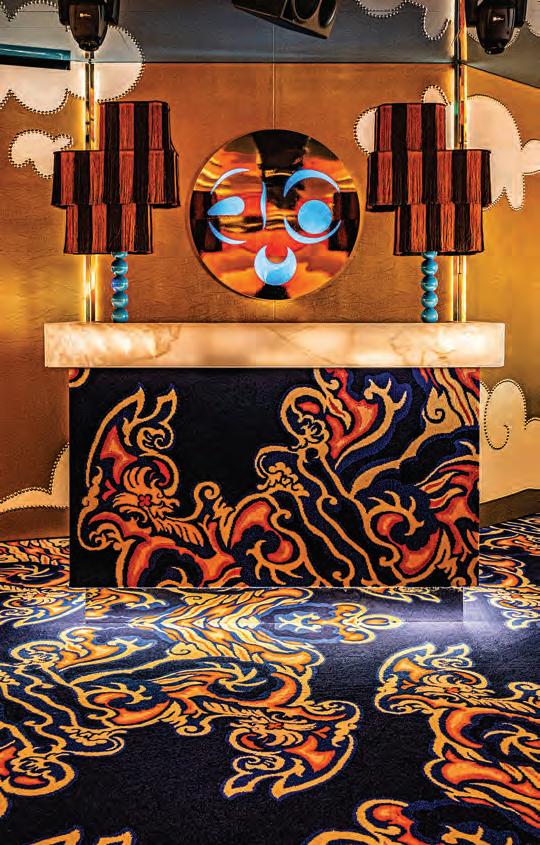
server to secure a contraband pack of Marlboros to join the smoking crowd upstairs in the members club (I don’t smoke, but…Europe). We hurry through a hidden, hushed corridor, past Miss Velvet offstage, and up to the smoker’s balcony.
“My wife and I decided to join forces,” Miguel tells me. “We want to create this ecosystem slowly through tiers of hospitality—shoppers, restaurant guests, club members, hotel guests. Our clientele is so loyal. We started thinking: what next?” The what’s next never seems to stop, and it’s a family affair through and through. Miguel and Paula, with their commanding elegance and old-world
beauty, are the living embodiment of the JNçQUOI ideal. Their children, Rui and Francisca Amorim, are also involved in the business, contributing to the brand’s vision for the future. Miguel, a Cornell Hotel School graduate, carries forward a legacy as well: his grandfather built the Four Seasons Hotel Ritz Lisbon.
The next morning at the beach club, JNçQUOI Comporta, Parisian girls pass out on sunbeds, recovering from flights or the night before, sipping coconut water from whole shells. I grab one for myself. After the technicolor whirlwind of Lisbon, I need the electrolytes. Lunch is fresh caught cherne and camarão
on ice. Fans hum softly overhead. Guests stretch out on the veranda overlooking the blue Atlantic. That night, fully restored, the sun sets over Comporta. JNçQUOI architect Vincent van Duysen pads softly around the clay tile floors of Casa M, his home with partner Mateo Bou Bahler. Their small dogs yip around us. Design lovers will recognize the house, with Brutalistmeets-modern-monastery angles and exposed staircases open to the pine-forest air. We crunch through sand in the surrounding yard, which is completely open to the house. Casa M is where the inspiration begins for the next installment in the JNçQUOI universe—a hotel and villa residences adjacent to the beach club. “When we announced it, we had people crying. They flocked,” Miguel says proudly. “Club members say, ‘I don’t want to purchase a house, I want a JNçQUOI house. I want it to be iconic.’”
Van Duysen’s work maximizes a continuous flow between living indoors and nature. The hotel will harness this barefoot sophistication in its purest form with terracotta tiles, wood and cork, textured concrete, and undisturbed coastal sightlines from green roofs planted with native grasses. The residences are a turnkey paradise with live-in butlers, two master suites, fireplaces, terraces, pools, and even plates and forks hand- selected by Van Duysen. Adjacent is the 18-hole Dunas Golf Course designed by David McLay Kidd and inspired by Scotland’s terrain. “There will be 64 private villa units,” Miguel mentions. “Well,” he smiles, “63 because one of them will be mine.”
CHINOISERIE SCENE
Frou Frou, a supper club and cabaret.
SCHOOL OF ROCK
THE DIRTY TURKEYS GOT TOGETHER WHILE STUDENTS AT THE UNIVERSITY OF COLORADO. WITH (RECENT) DIPLOMAS IN HAND, THEY’RE PRIMED FOR GLOBAL ROCK N’ ROLL STARDOM REPORTS PETER DAVIS
TPHOTOGRAPHY BY ANGELLI NGUYEN AND CASS REIT
here is an unsung tradition of famous rock bands forming while still in school. The Strokes met as high schoolers at New York’s tony Lycée Francais, the Talking Heads got together while studying art at RISD and Phish started as a college jam band at UVM. The Ramones, who met at Forest Hills High School in Queens, famously sang Rock N’ Roll High School. What better place than school to be heard by throngs of young students, their ears hungry to absorb the latest sound? The newest band to emerge from the halls of higher education: The Dirty Turkeys—four recent graduates of the University of Colorado in

HUDDLE UP The Dirty Turkeys (from left): Ty Tullar, Russ Hansen, Sam Baker, and Brad Hansen.


Boulder, in the foothills of the Rocky Mountains. Once the de facto house band at countless rowdy CU Boulder parties, The Dirty Turkeys (brothers Russ and Brad Hansen, Sam Baker, and Ty Tullar) now fill concert venues coast to coast. At graduation, the band got a jolt of internet virality when Baker, sporting a top hat emblazoned with the band’s name, threw up—thanks to a late-night party the night before—in a large trash bin in front of hundreds of guests during his graduation ceremony. Video of this “Vomitpalooza” clocked over 274,000 likes on Barstool
Sport ’s TikTok account. “My poor mother,” Baker relents. “She wasn’t stoked about that, but I made it up to her. A bunch of moms came up to me after to try to take pictures with me. I was like, ‘Please stop.’” Talk about a Spinal Tap worthy rock star graduation scene. And speaking of stomach sickness, the band found their name after a thermometer exploded in a turkey during Thanksgiving and the Hansen’s mother Biz exclaimed: “That’s one dirty turkey.”
The Dirty Turkeys’ sound–trippy psychedelic rock sliced with country twang and punk angst—
“In high school, I was a jock and in the chess club. People from back then don’t even recognize me now.”
BRAD HANSEN
YOUTHQUAKERS The Dirty Turkeys photographed in Boulder, Colorado.

ON THE ROAD Lead singer Brad Hansen.
The Dirty Turkeys’ sound–trippy psychedelic rock sliced with country twang and punk angst—is best experienced live.
is best experienced live. Lead singer Brad Hansen, an avid surfer and extreme sports enthusiast (passions all four members share) struts the stage with the sinewy, sexy bravado of Mick Jagger and the theatricality of Tim Curry as Frank-N-Furter in The Rocky Horror Picture Show. At outdoor shows, Hansen shimmies up trees, crooning while perilously hanging from a branch. “I’ve always wanted to be a lead singer. I had that in me,” Hansen says. “In high school, I was a jock and in the chess club. People from back then don’t even recognize me now.”
Self-taught musicians (Russ and Sam learned guitar via YouTube tutorials), the Hansen brothers penned most of the songs on the band’s debut album Cowboy Caravan. The band already has a stadium-worthy anthem: “Quinceañera” (about being drunk at a 15-year-old’s birthday party) which they often close live shows with, the audience morphing into a frenetic mosh pit. “That was our first song. It’s about raw and primate expression. When we close with “Quinceañera,” we usually destroy the stage,” Russ Hansen says with a mischievous laugh. “I hope someday to get invited to a real quinceañera. But I don’t know any 16-year-olds, which is probably a good thing.”

SCHOOL’S OUT The Dirty Turkeys met while at CU Boulder.

GOIN’ GONZO
The Dirty Turkeys frontman Brad Hansen.
A documentary film crew has been trailing the boys along the way capturing their live shows and daredevil Jackassstyle stunts like mountain biking over
cliffs and playing electric guitar in a freezing cold river.
The Dirty Turkeys spent the summer touring all over the west, playing L.A.’s famous Viper Room and The Fox Theater in Boulder. They’re now in the studio cutting their second studio album Soul Sugar (which Brad Hansen describes as “controlled chaos–in between face melting fuzz and glamorous acid rock”) and are setting off on a coast-to-coast tour. A documentary film crew has been trailing the boys along the way capturing their live shows and daredevil Jackass-style stunts like mountain biking over cliffs and playing electric guitar in a freezing cold river. “My favorite part of being in the band is the community we have formed,” says Baker. “We have this ability to attract interesting and cool people. We’re like a family and we are having the time of our lives.”
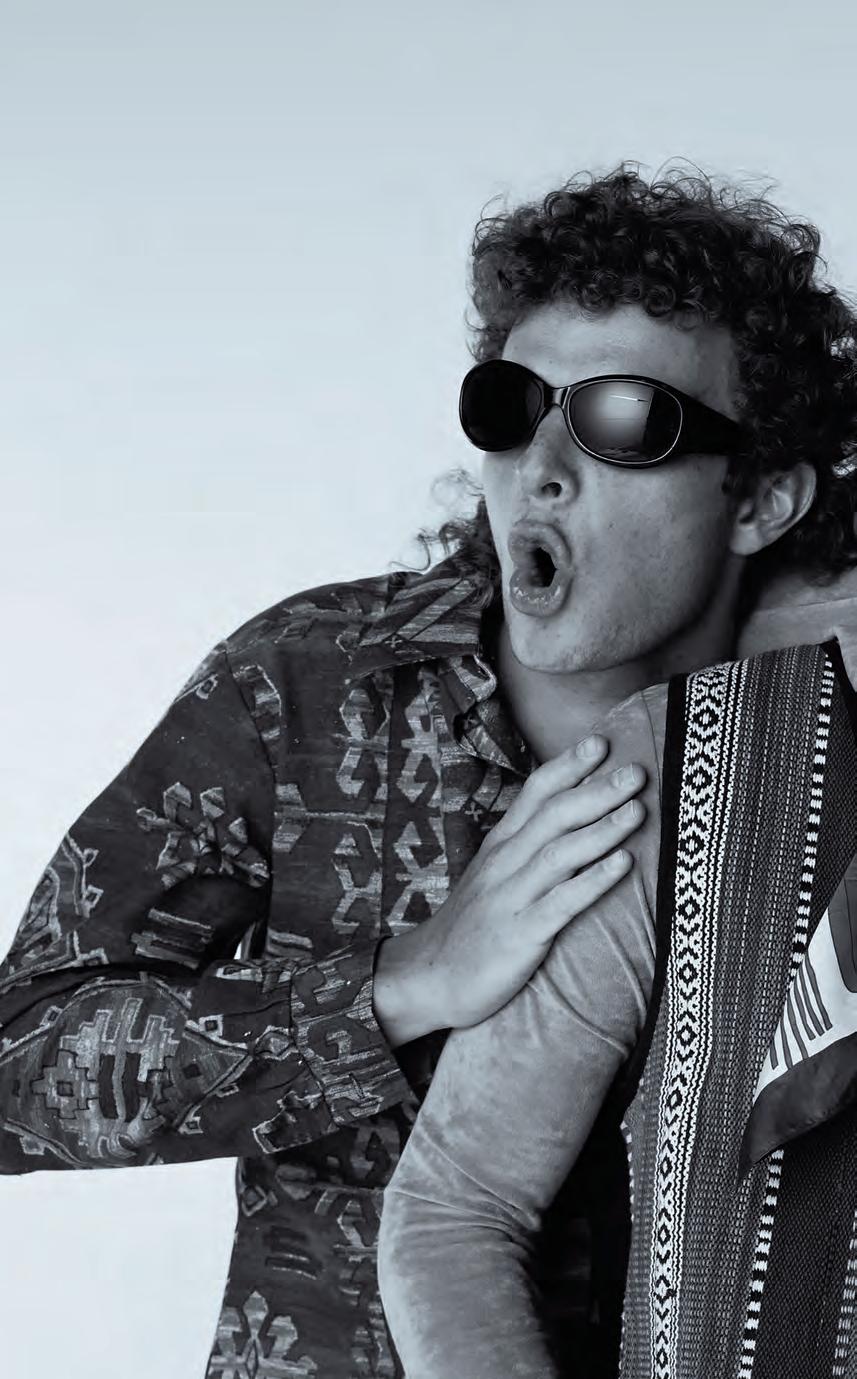
ROCK’S FUTURE Russ Hansen, Sam Baker, Brad Hansen, and Ty Tullar.


FORTE DEI MARMI: THE HAMPTONS OF ITALY

Forget another weekend in Sag Harbor, decides Janet Mercel, who books a trip to Italy’s answer to the Hamptons: the Agnelli-family approved Forte dei Marmi.
THE SPIAGGIA SCENE The spread at the Augustus Beach Club on Forte dei Marmi.

It’s high summer in Italy, and where are all the Italians? If they’re fashionable Romans or Milanese, they’re on the Tuscan Riviera, along the Versilian coastline. “Forte,” as in Forte dei Marmi, has been the escapist enclave for Italian aristocracy since the 1930s. Giorgio Armani had a house here and so does Andrea Bocelli and various crown royals. And if they’re very chic, you can narrow the pin drop all the way to the five-star Augustus Lido Hotel.
Just off Viale Morin, the main drag, a few minutes from Brunello, Loro, Miuccia, Gucci, Fendi, and Dior, the tree-lined streets grow hushed and smell of fresh pine, hot rosemary, and jasmine. Mile-high hedgerows shield a line of villas from the merely curious, evoking Forte’s well-earned moniker: the Hamptons of Italy. A discreet Augustus crest hangs over the glossy, lacquer-red drive to the main entrance, lined with scarlet geraniums. It is the Sophia Loren of driveways.
The grounds of the Augustus sit between the soft sand of the Tyrrhenian Sea and the Apuan Alps. I thought California did beach-plus-mountains well, but the Mediterranean is altogether something else. My husband winds through mountain valleys and the Cinque Terre. Our fully electric rental car is down to two minutes of power right before we pull up to the hotel charging station. The heat has crept to nearly 38C. My three-yearold, Sloane, silently stews in the backseat. We hand over our keys to a man who is less valet, more like a kindly, patient uncle. I sigh with relief. I’m always curious how grand hotels really feel about children, especially small ones. Then I remember—it’s Italy. My daughter climbs out and we’re ushered under the green striped awnings and through the per-
TABLE FOR TWO
A common area at Villa Radici.
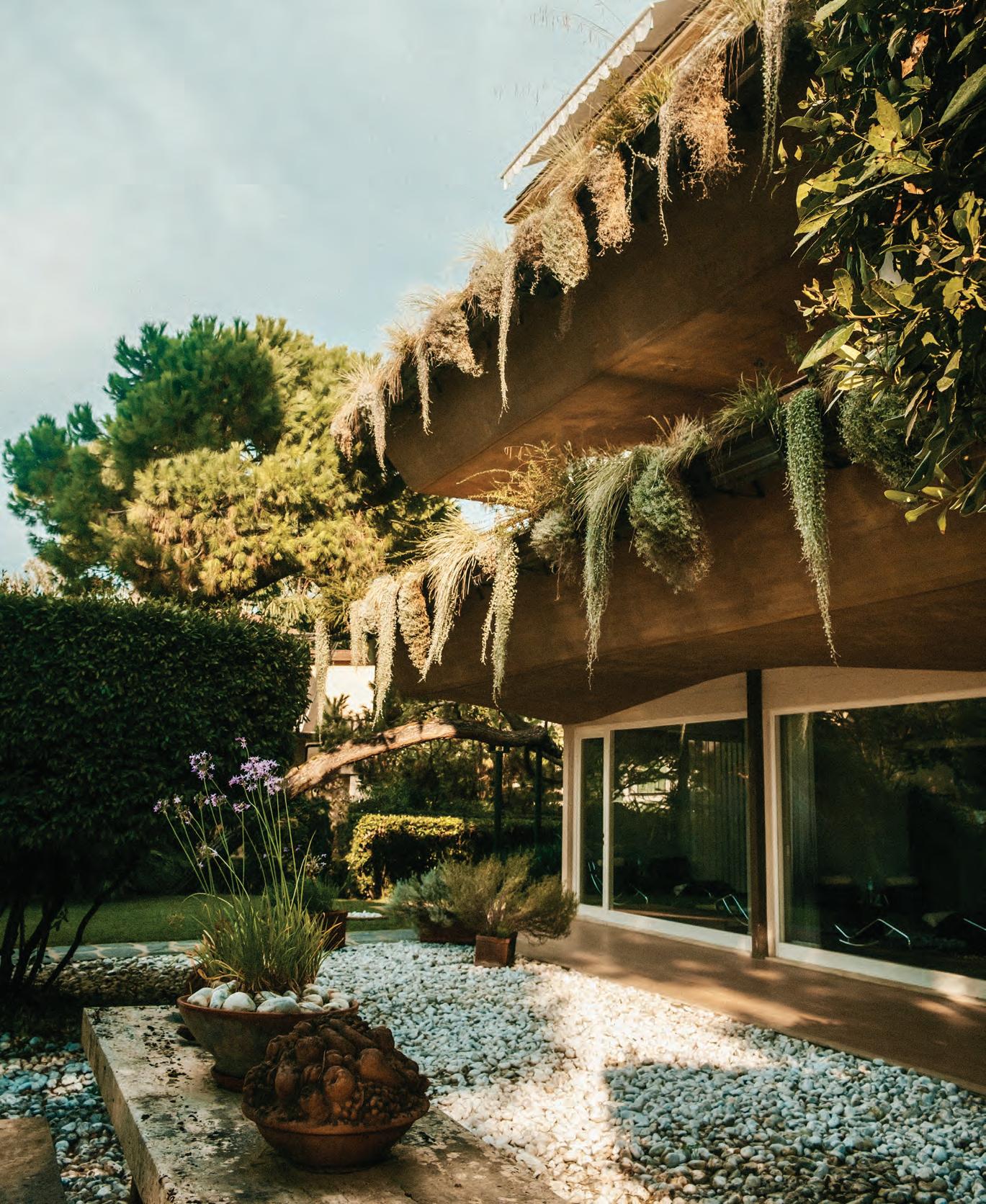
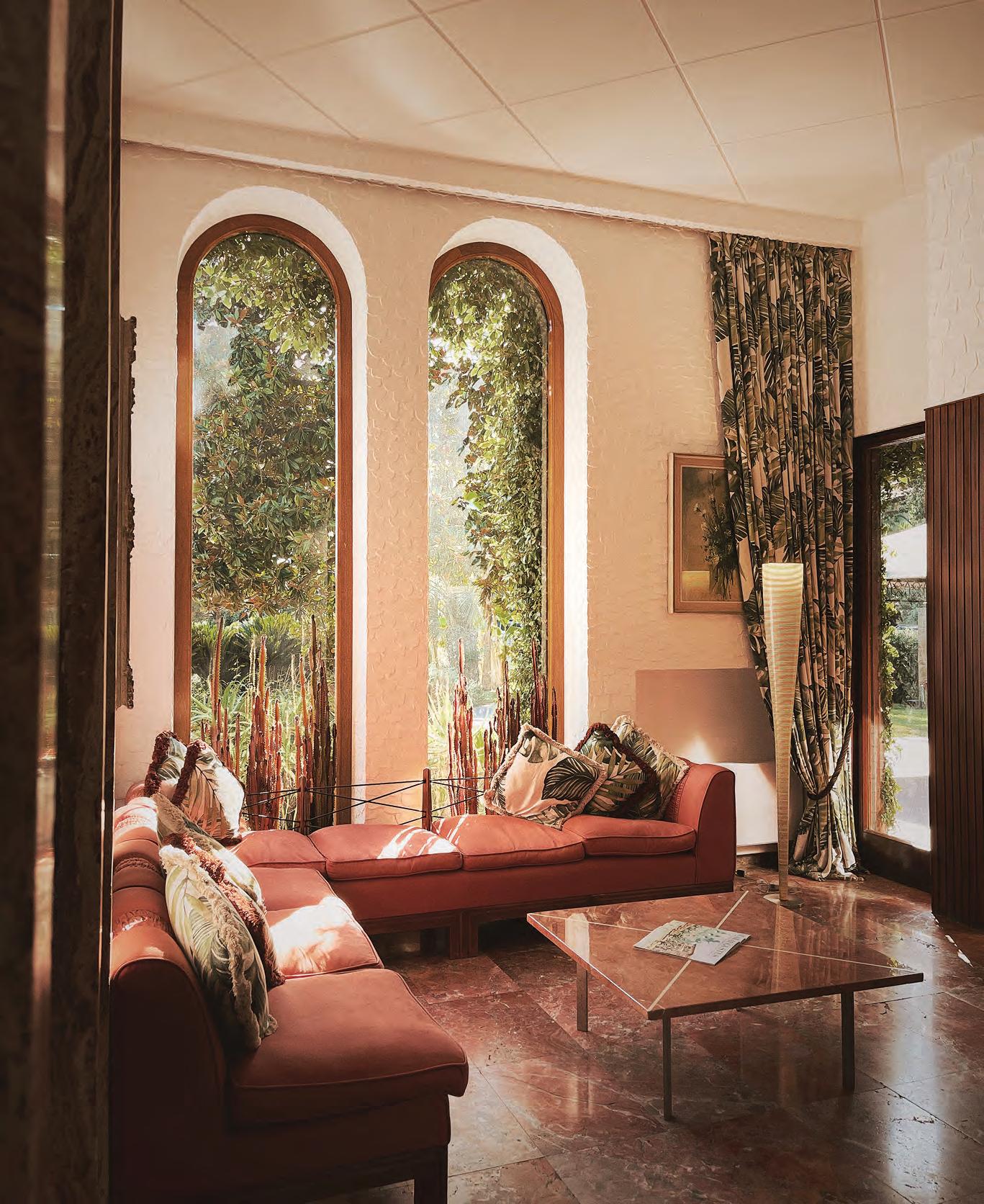
IT BEGAN WITH THE AGNELLIS, WHO ARRIVED FROM TURIN IN 1926 AND BOUGHT A NEO-RENAISSANCE VILLA FROM A RETIRED ADMIRAL.


gola-shaded entrance. She tumbles on terra cotta colored velvet cushions in the lobby, thrilled to be out of the car.
It began with the Agnellis, who arrived from Turin in 1926 and bought a neo-Renaissance villa from a retired admiral. It was their seaside retreat for 30 years, and the rest gradually sprung up around them. In 1939, arts patron and society hostess Augusta Pesenti discovered a rising star architecture student, Osvaldo Bersani, and commissioned him to design her own adjacent villa as a graduation project. Her sister, Barbara Radici, followed suit next door. At the height of la dolce vita in the 1950s, Augusta added a second floor to her mansion, then a third house, which became the hotel. The three buildings form the resort, along with seven villas and the 1960s-era La Nave, (“The
Ship”) nautical inspired, 1960s-era lodgings. Bersani would go on to become one of Italy’s most influential Modernists, designing homes for the likes of Ermenegildo Zegna.
Villa Pesenti is the resort’s crown jewel and the hub. It’s easy to imagine the many parties with Fellini-esque characters overflowing into the gardens. We are in the main house, above the lobby with original red travertine arches, columns and floor with regal veining. This is marble country; Forte dei Marmi means “Fort of Marble.” Nearby, Pietrasanta is a centuries-old sculptor’s mecca and thirty minutes up the coast, Michelangelo sourced his blocks from Carrara.
Our suite is pure cinema romance from the brocade bed with crest-monogrammed linens to the sun-spilled balcony that runs from our room
to the sitting room-turned-baby nursery. The pièce de resistance is the tiny spiral staircase up to a boudoir hideaway tucked under the eaves. It might have been a captain’s office or a private dressing area, which would explain a third walk-in closet tucked inside. These mysteries are what make the romance of the hotel.
It’s morning and I audibly gasp as I enter the dining room. The spread will take your breath away. Fresh bowls of Irish sea moss, grilled tomatoes, cloud eggs, tables groaning under layers of Italian pastry and formaggio, juicy figs, chicken and turkey wurstel, carrot or vanilla plumcake, more jars of seeds and dried fruits than a wall at Dylan’s Candy Bar, a full box of honeycomb, and icy buckets of Ferrari Brut. For the diet-restrictive, there’s even savory vegan cake, seitan chorizo, and
MAKING A SPLASH
The Augustus Beach Club.
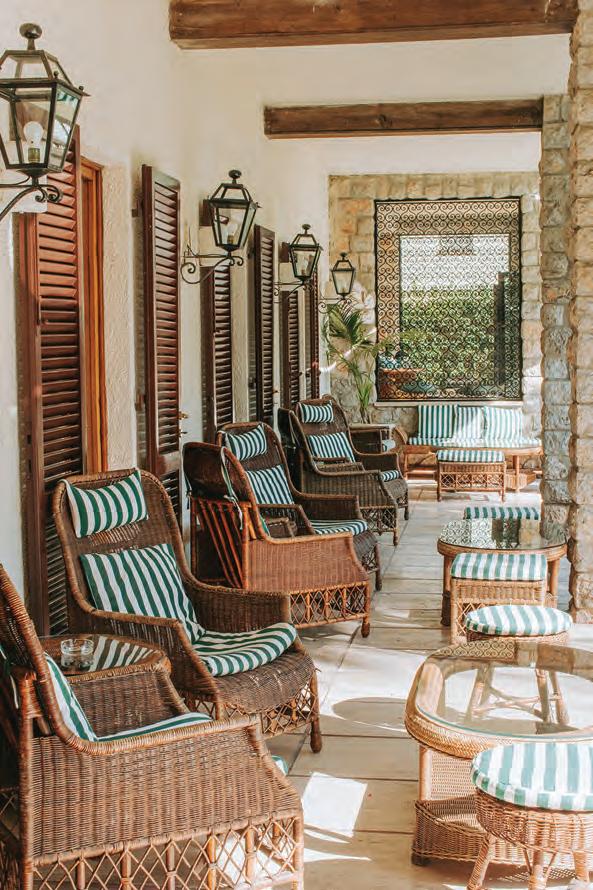
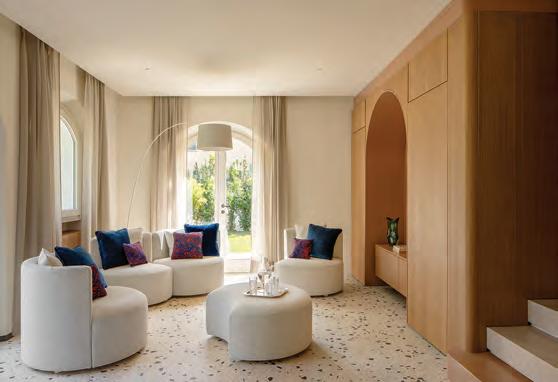

MODA ITALIA The veranda at Villa Pesenti, a common space and guest bath at Villa Radici.
IT’S EASY TO IMAGINE THE MANY PARTIES WITH FELLINI-ESQUE CHARACTERS OVERFLOWING INTO THE GARDENS.
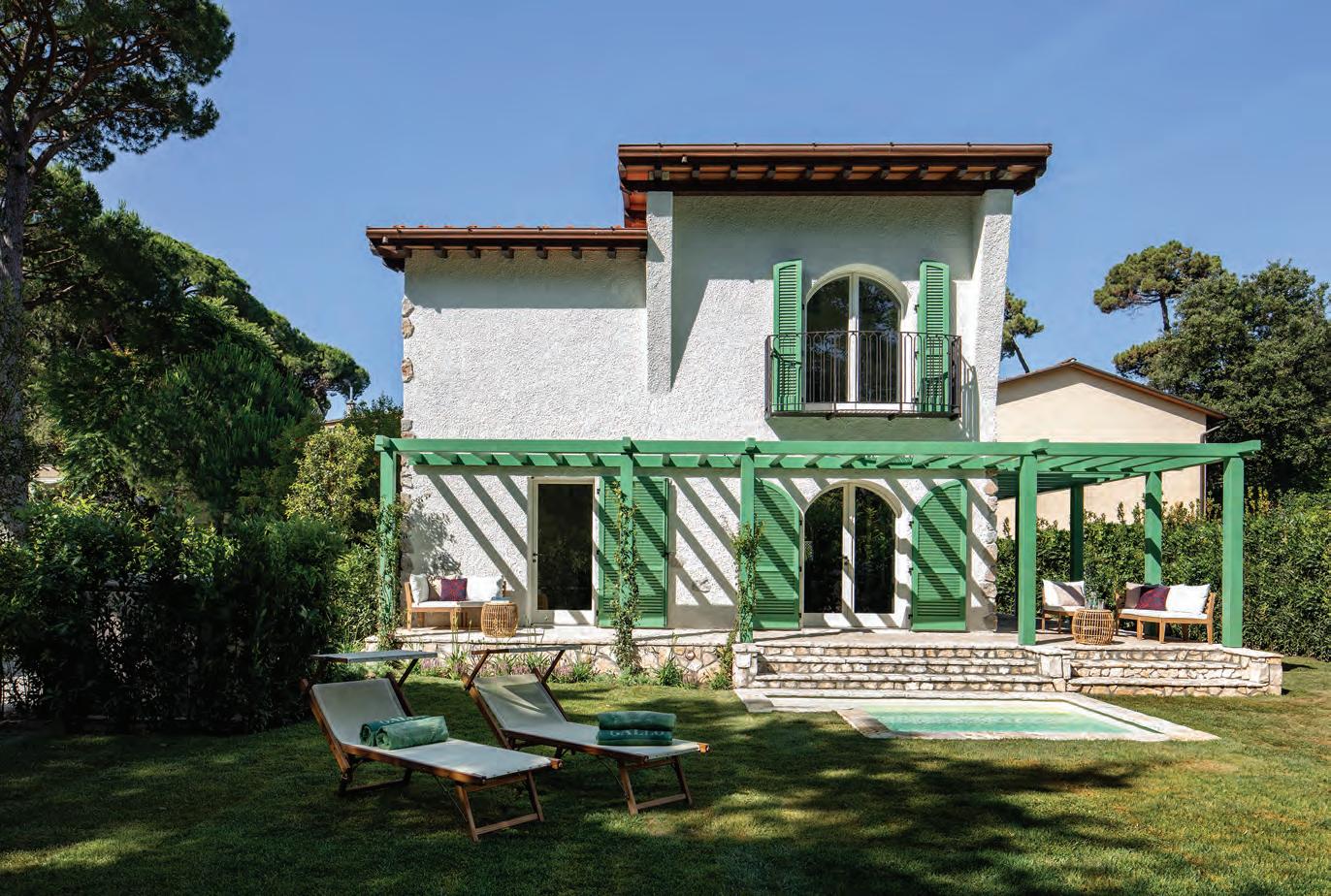
soy cheese. Then there’s the “kid’s corner”—miniature pink creme donuts, parfaits, and sprinkles for everything.
But before we forget why we came here—why everyone comes—we head to the beach club. It’s our third bagno in two days, and while Italian beach culture has its charms, this day is one of the best of our two weeks in Europe. Crisp white cabanas line the shore like little maharaja tents. The seaside bungalow restaurant and lounges are nearby if you’d like to take a break from the sun and
sand. Everyone—from attendants to lifeguards— is attentive without being overbearing, dressed in crisp uniforms that echo tennis whites with sharp red accents. And if you’re traveling sans nanny, there’s a team in place for poolside play, surf and swim lessons, too.
Despite hours of sun and Aperol spritzes crushed between us, there was no over-beached feeling—just the rare sense that nothing was missing. It’s true I came with my family, but had it been adults-only, I would have been just as happy.
Our cabana neighbor, the enviably tan solo lady in head-to-toe Chanel drag—maillot, sunglass chain, and an oversized beach bag we could have toted Sloane in—who carried on three subsequent cell conversations in three different Romance languages—was doing just fine.
Teddy Roosevelt: the Fifth Avenue Gladiator
By Janet Mercel

In the opening scene of The Social Network, Jesse Eisenberg (playing Mark Zuckerberg) spars with his girlfriend over Harvard’s Final Clubs. “Teddy Roosevelt didn’t get elected president because he was a member of the Phoenix Club,” she scoffs. “He was a member of the Porcellian,” Zuckerberg corrects her, “and yes, he did.” The ghost of Roosevelt looms again when she breaks up with him: “It’s exhausting. Dating you is like dating a Stairmaster.”
The influence of Roosevelt’s college social life on his political rise is up for debate, but we do know that (like Zuck) he was famously as exhausting as a piece of exercise equipment. Early on he was dubbed “The Cyclone Assemblyman.” He was a reckless, whirling dervish and a permanent adolescent, his colleagues said—sometimes with love, sometimes not. Roosevelt nourished daydreams of himself as a figure out of the Roman empire, happiest as a gladiator in the pit. From his famous “Man in the Arena” speech: “Whose face is marred by dust and sweat and blood, who strives valiantly…”
Before he was the youngest (still today) president, or even governor of New York, Roosevelt was a cheerful imperialist and warmongering
jingo, who restlessly if distinguishably served as Assistant Secretary of the Navy in 1898 while U.S. tensions with Spain simmered over Cuba. Openly bloodthirsty and eager to prove himself a warrior, he was increasingly frustrated with a passive McKinley. He mocked the president who had no interest in revisiting the horrors of the Civil War, as having “No more backbone than a chocolate éclair.” While Roosevelt’s boss, the Secretary of the Navy, was away at the osteopath, he launched a flurry of unauthorized orders and kicked off the Spanish-American war.
Having gotten his battle, Roosevelt quickly resigned from the Navy to join the Army and the Rough Riders were born. They were an infamous, handpicked band of toughs who, according to Roosevelt, won the war nearly singlehandedly. Never mind that only a few made it to shore on horseback as most of the regiment had to leave their horses back in Florida. Cavalry became infantry—more rough, than rider—and the nickname stuck. Roosevelt’s early instincts for publicity put today’s attention hounds to shame. Even the battlefield was a photo opp. Before most Americans had even seen a camera, he was staging war scenes. The famous photograph of Roosevelt with his men in
COMES A
HORSEMAN Teddy Roosevelt’s most iconic photo.
Cuba is one of the most reproduced in U.S. history. He charged into battle not once, but twice, to make sure the journalists captured him looking properly heroic.
Much of Roosevelt’s history comes from his own books, which, unsurprisingly, offer an incomplete picture of the man. (Beyond self-mythology, he had his reasons for writing more than 30. Sagamore, his Oyster Bay estate, was expensive, and he spent more than he earned—he needed the money.) Rumor has it that for his 1899 book The Rough Riders, the printer had to order extra type for the letter “I” because he used it so much.
The images forever skyrocketed Roosevelt into national legend, a part he was born to play: always in character. He was a war colonel fully outfitted in Brooks Brothers togs. A Badlands baddie in buckskin carrying a Tiffany bowie knife with an elaborate repoussé silver handle he adored. (You could take the boy off of Fifth Avenue, but you couldn’t take Fifth Avenue out of Teddy.) Roosevelt was raised on the best block in the city, 5th and 57th Street, the same lot where the Cornelius Vanderbilt II mansion would be razed to make way for Bergdorf Goodman. His father founded both the Met and the American Museum of Natural History. When everything north of Central Park was goat pasture, his grandfather was one of Manhattan’s five richest men at a time when there were only about 70 millionaires in the country.
“THE FAMOUS PHOTOGRAPH OF ROOSEVELT WITH HIS MEN IN CUBA IS ONE OF THE MOST REPRODUCED IN U.S. HISTORY. HE CHARGED INTO BATTLE NOT ONCE, BUT TWICE, TO MAKE SURE THE JOURNALISTS CAPTURED HIM LOOKING PROPERLY HEROIC.”
Industrial Age New York was still not an easy place to grow up, and Teddy Jr. spent his Gilded Age childhood scrawny and dusted with city soot. He was chronically sick, asthmatic, bullied, and lived in near-constant pain and fear. Teddy Sr. built him a gym in their brownstone, so he took boxing lessons from a prizefighter, started wrestling, and lifted weights. By the time he was at Harvard, he was a bruiser with mutton chops—eccentric, hyperactive, high-pitched—but there would be no failure for Roosevelt. There was the Porcellian Club and the Dickey. When he met his first wife, Alice, he pursued her the same way he did everything: obsessively. She died just three years later on Val-
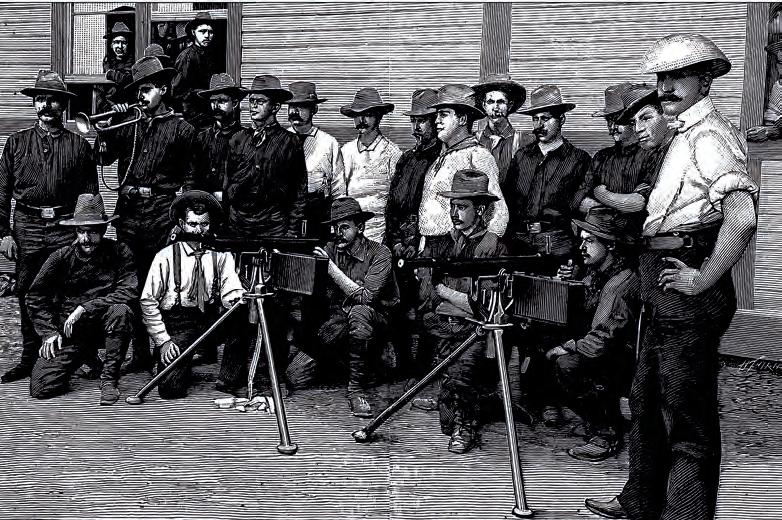
entine’s Day, the same day as his mother, under the same roof, two days after giving birth to little Alice. Roosevelt declared the house, and himself, cursed, romanticized his misery and openly pledged a life of eternal sorrow in which he would never love again.
But there was a tarnish on his perfect—and entirely fabricated—devotion. Despite insisting Alice was the only girl who’d ever caught his attention, he’d loved his best friend, Edith Carow first. (When she broke up with him as a teenager, he went on a violent bender, shooting a neighbor’s dog, and then, while sailing on Long Island Sound, anything that moved in the water: buoys, sharks, dolphins.)
As a widower, he tried to avoid the temptation of Edith, but his heart (or something) won out. “Within two years he got pretty well over it all,” said one of his cowboy buddies out West when they married a couple years later. He was so embarrassed by his failure of loyalty to Alice’s memory—and the quick remarriage was considered so unthinkably scandalous—that when the New York Times announced the engagement, his furious sister demanded a retraction, and Roosevelt had to sheepishly write her with the truth.
Roosevelt’s natural state was nursing a bruised and battered body, not heart. Tiny Alice recalled her father returning from a fox hunt with a broken arm and a bloody nose, a disturbing, if familiar, sight. “I started screaming at this apparition and he started shaking me to shut me up, which only made me scream more. So, he shook me more. It was a theme which was to be repeated, with variations, in later years.”
Shaking things into submission was a theme in general for Teddy. While running for a third presidential term, Roosevelt was shot by a saloonkeeper at a rally. The bullet didn’t kill him. It lodged in his chest, stopped short by 50 pages of a speech in his breast pocket and, as the papers noted, a generous layer of torso muscle. As a seasoned hunter, he knew he was fine. He wasn’t coughing blood and insisted on finishing the infamous “speech that stopped a bullet” while bleeding through his shirt, before letting anyone take him to the hospital. Never one to miss a photo opp, Roosevelt crowed to the crowd, “It takes more than a bullet to stop a Bull Moose.” He lost the election but carried the bullet in his chest for the rest of his life.
HIS GANG “Rough riders” of Colonel Roosevelt.
JAMES FRANCO
The controversial, conceptual-art loving, Academy Award-nominated actor JAMES FRANCO has a new DIY label called Paly with partner Kyle Lindgren. Paly’s mission? Using images and words to turn Hollywood’s hidden, often-dark history into fashion. Franco tells Maggie Davis how movieland myths collide with punk rock sketches in his first fashion line.

Paly time travels and uncovers secret, sometimes sordid Hollywood stories. It’s about vintage California legends. One story is the Haight-Ashbury Free Clinic. They would treat hippies for free. Their saying was “Love Needs Care.” Most people won’t understand it. I just like the saying: “Love Needs Care.” It was the beginning of the hippy movement. The clinic is still there.
The line celebrates film and theater, two of your loves.
The Living Theater puppets were this avantgarde theater group in New York. They were off-off Broadway doing very weird stuff that now has bled into the mainstream. It’s what we are watching in crazy horror films or Anora
What inspired you to enter the fashion world?
Our north star for all the designs and themes is Kenneth Anger who wrote a book Hollywood Babylon. Essentially, he took these old, silent-era stories and sort of exaggerated and distorted them. But he also turned them into something more—myths, like a weird materialistic religion. That’s what I like to do— use subjects and turn it into something else, all framed in a punk presentation. It’s a history lesson, but new and alive. In each piece, there are different stories.
What are some other stories?
Michael Cimino. He directed The Deer Hunter which won Best Picture. He felt like he was the king and then did Heaven’s Gate right after and that was a disaster, the end of an era. Although it is a beautiful movie, at that time it was like… disaster. All these things are part of a bigger image, using and repurposing Hollywood legends into something bigger. It all points to bigger things, kind of like movies do.
You’re an actor, writer, director, and now fashion designer.
As a filmmaker, I’m interested in Hollywood history. I’ve done movies about filmmaking, and I’ve done films about bad filmmakers. There is a common theme as far as the DNA. This is all about old Hollywood. Sometimes I write a script about an older actor or actress, or I make clothes out of it and tell the story that way.






ICE CUBE
